#no mention of which nation. manga not well known enough for anyone to
Explore tagged Tumblr posts
Text
suddenly remembered that i have volume 7 of the manga et cetera and found out that its all on mangadex. time to actually read it in full
#this was like way back before manga became ubiquitous in bookstores i think#buncha volumes for sale. one of them was this one#another was the demon ororon#both published by tokyopop. thats how old they are LOL#i remembered that there were native american characters and wanted to see how that held up#no mention of which nation. manga not well known enough for anyone to#judge the representation....#the art style is soooo fun too
15 notes
·
View notes
Photo
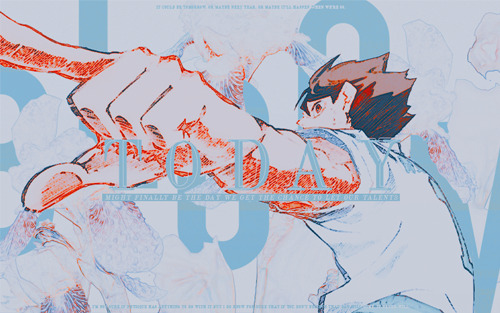
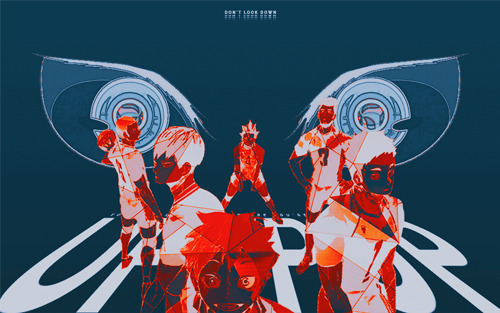
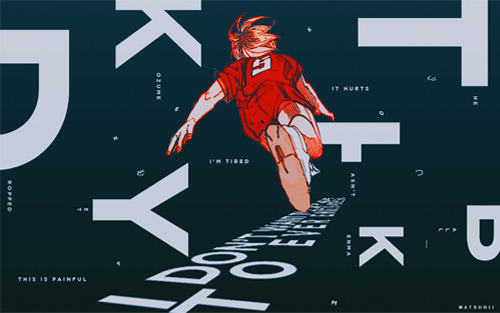

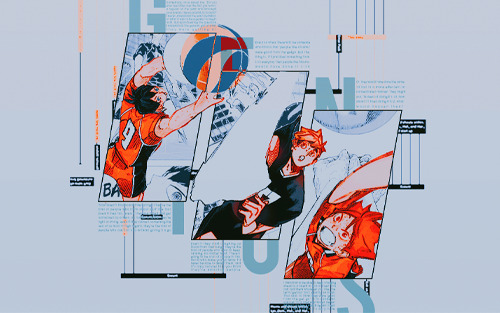
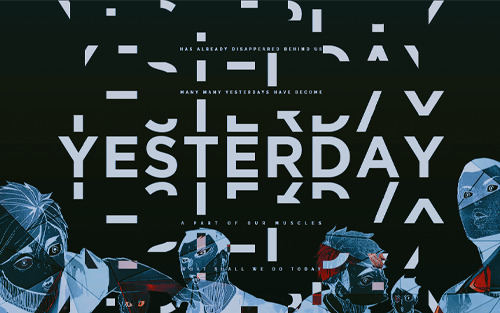
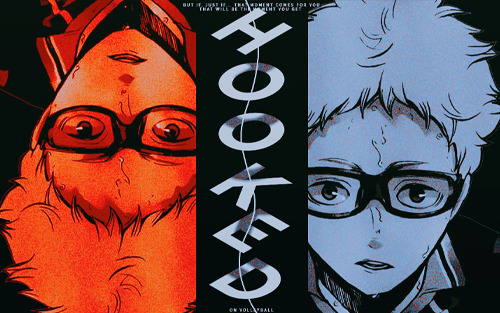
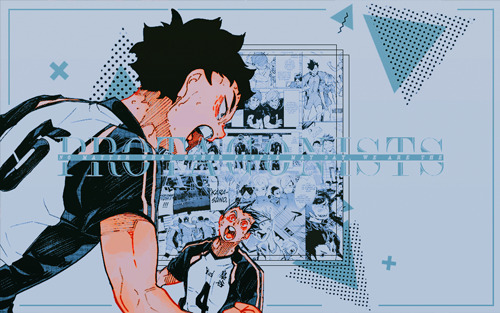
Happy Haikyuu Day!
Sorry for the bad quality first off T^T I keep having to resize these so that they’re smaller for Tumblr and it ruins the quality. But more importantly, happy Haikyuu day! (at least it is Japan already!) This edit embodies some of my favorite moments within the series and below, I’ve written some of the thoughts that went into this piece/my feelings on these moments! Manga spoilers ahead (I'm pretty sure I’ve kept them to a minimum but just to be sure, please proceed with caution!), and I hope you enjoy this edit! (Overlays: accio-glow, aulia-chan on dA; PSDs: hurtears, hallyumi, yangyanggg on dA) 1. “Today might finally be the day we get the chance to let our talents bloom… it could be tomorrow. Or maybe next year. Or maybe it’ll finally come when we’re 30. I’m not sure if physique has anything to do with it but I do know for sure that if you don’t believe that day will come, it never will.” This quote is a testament to Oikawa’s growth and is a symbolic representation of Oikawa freeing himself from the shackles of “geniuses” and “prodigies.” So what if your opponent is a genius? So what if they possess more innate talent? As his mentor and inspiration Jose Blanco states, “Are you saying you know what the limits of your abilities are already? Even though you aren’t yet finished growing physically or mentally? Even though you haven’t mastered all the skills you can master? If you’re going to complain that someone with more talent than you will always be better than you… no matter how hard you work, how many tricks you learn and how many great teammates you have… do that only after you’ve given everything the very best effort you have.” There will always be someone better in the world. But to claim that you cannot hope to compare to the likes of them is to resign yourself to a predetermined defeat as well as dismiss both your own efforts and theirs. There’s no guarantee when your efforts will pay off. As Oikawa declares, it may be today, tomorrow, or even when we’re 30. But if you don’t believe in yourself first, if you don’t believe that you will bloom in your own time, “that day will never come.” The flower in the background is the iris. It is known to represent trust, faith, and hope amongst many other ideals. I chose this particular flower because of the manga cap used in this panel. I cannot emphasize how much I love the bond between Oikawa and Iwaizumi, especially this particular moment when Oikawa points at Iwaizumi with such authority and determination as if saying, “This ball, this moment, is meant for you.” Not to mention the pairing with the iconic “Talent is something you make bloom, instinct is something you hone” quote. An absolutely masterful sequence of scenes that always gets my blood rushing.
2. “Don’t look down! Volleyball is a sport where you’re always looking up!” This moment gives me chills every time. It’s something so fundamental and simple and yet, when Ukai yells this, it instills that feeling of “You can do it.” It makes my heart flutter and I feel so excited because it’s such a beautiful way of saying “Don’t give up, it’s not over yet.” And even if the ball has dropped for the last time or you have lost this match, there’s always tomorrow. There’s always the next match where you’ll have to look up. This quote gives me the same feeling as when Takeda-sensei says, “For the rest of your lives, you can do anything you set your mind to!” You only truly lose when you stop trying or you give up. 3. “It hurts. I’m tired. This is painful. I don’t want this to ever end.” / “The ball hasn’t dropped yet!” Whenever Haikyuu characters say “Just one more!” or “The ball hasn’t dropped yet!”, the tension and desperation is almost palpable. It’s so incredibly moving to see them strive to save that ball just one more time, to focus purely on what is in front of them. Even if they don’t all pursue volleyball as a professional career, the passion they all have for the sport is real. That sort of passion is beautiful to watch and admire, and I wish I could have that kind of passion for something in my life. 4. “The underhand only uses two hands. The overhand uses 10 fingers. That’s all the more to support your spikers with, which is what it means to be a setter.” / “To cut through the wall that looms before your spikers, that is the purpose of a setter.” This particular panel depicts the two ideologies of Atsumu and Kageyama respectively, two of my favorite setters and characters in general. Atsumu “may be pretty cocky at times, and overwhelm his teammates with his thirst for victory, but he treats his spikers with more sincerity and selflessness than anyone else.” He may be overbearing and an asshole at times, but his love for the sport and the art of being a setter is second to none. On the other hand, there’s Kageyama who’s so damn cool with his one-liners. Kageyama’s passion and drive to win may blind him to his surroundings and teammates but he truly believes that the setter is the one who clears the path for their spikers. When their spikers feel cornered and the walls are closing in, it is the setter who “cuts through the wall that looms” ahead. The old Kageyama who was a prisoner to speed is no longer, and his growth as a player brings me to tears every time. 5. “Someone once asked me, ‘Do you ever feel bitter over the fact that you’re not a regular on the team, and amongst your juniors there’s a genius to boot?’ I never understood the exact definition of what it was to be a genius to begin with, but upon hearing the question, I understood the general gist of what they were getting at. Every so often there will be someone who thinks that ‘people like Atsumu’ were ‘good’ from the get-go. But the thing is, if I practiced something from 1-10 every day, then people like Atsumu would have done it from 1-20. Or, they would have done the same 10 but in a more efficient or concentrated manner. They might also ask ‘Instead of doing it 1-10, how about I tried it from A-Z, what would happen then? Now doesn’t that sound interesting?’ They’re the kind of people who think about stuff like that. Even if they fail, even if they are hated and get ostracised by others, no matter whether they’re right or they’re wrong, even if they subvert something the rest of us hold in high regard, they’re the kind of people who can’t sit still without giving it a go. Even if they start coughing up blood from their lungs, they’re the kind of people who want to keep on running, no matter what. There’s going to be a lot of people in this world who make you go ‘Wow, I’ll never be able to defeat them,’ and it’s only natural that you think they’re amazing people. I think that to be able to keep charging ahead is a talent in and of itself. You can call people like them whatever you like, the term ‘genius’ isn’t exactly an insult. That said, to think they were ‘good from the get go’ is to condemn yourself to a predetermined defeat without even playing a match against them, and I also think it’s very rude.” This quote, hands down, is one of my favorite quotes of all time. It is not genius or natural talent that makes individuals truly great, but it is grit. Without a doubt, people are not born equal. There will always be someone with more innate talent or latent capabilities. We all begin at different starting lines. But those who truly stand out are those who go the extra mile, like those dubbed to be the Monster Generation (Kageyama, Atsumu, Hinata, Bokuto, Ushijima, Oikawa, etc.). To others they may seem like natural prodigies but behind their flawless technique and precise ball control lies countless hours of training. They trained harder than anyone else, sacrificed in order to hone their abilities, and ran farther than the rest of the pack. They’re the type to fixate on what lies before them without much regard to anything else.They eat, sleep, breathe, and live volleyball with every waking second. They’re always trying new things (Atsumu pulling off the freak duo quick in the middle of the Inarizaki match) and continually looking for ways to improve (“But the thing is, if I practiced something from 1-10 every day, then people like Atsumu would have done it from 1-20. Or, they would have done the same 10 but in a more efficient or concentrated manner. They might also ask ‘Instead of doing it 1-10, how about I tried it from A-Z, what would happen then? Now doesn’t that sound interesting?’ They’re the kind of people who think about stuff like that”; Kageyama keeping a volleyball journal). It is not what they were born with that makes them great; it is their overwhelming desire to win. 6. “‘Yesterday’ has already disappeared behind us. Many, many yesterdays have become a part of our muscles. What shall we do, today?” This quote, chills. There’s no point ruminating about the past or what has already passed; you can’t change it. (In retrospect, I wish I included another quote from Inarizaki in this panel: “One time is enough. We rise to the challenges of today.”) You learn from the mistakes of yesterday and use them as stepping stones for tomorrow. I wish I could eloquently phrase how much I love this quote or my interpretation of it but alas, my writing is fancy Garbage. 7. “But if… just if… that moment comes for you, that will be the moment you really get hooked on volleyball.” If you didn’t get chills when Tsukishima blocks Ushijima, I have no words for you. Tsukishima-it’s-just-a-club Kei, Tsukishima-I’m-the-normal-guy Kei — Tsukishima Kei, who always underestimates his own capabilities and relies on what he can see in front of him, blocking the Ushijima Wakatoshi, one of the top three high school aces nationally. The character development from someone who did the bare minimum (as noted by other players/coaches at one of the training camps) to someone who finally had their moment to get hooked on volleyball is one of my favorite progressions of all time. Seeing him fall in love with volleyball gradually and then all at once is truly heartwarming and beautiful to witness. 8. “No matter what other people may say, we are the protagonists of the world.” This quote is incredibly empowering to me. Even if your days consist of mundane activities, you are the protagonist of your own story every day. You may not be the main character in a shounen manga or an adolescent seeking to usurp the government in a dystopian novel, but this is your story. No one can tell it like you do and no one can replicate your story. It is yours and yours only. And that concludes my Haikyuu word vomit! I really do wish I could have properly conveyed my pure adoration and love for this series better. I truly do love Haikyuu so very, very much. It will always have a special place in my heart and I will never forget the memories and lessons it has taught me! Thank you, Furudate-sensei, for such a beautiful story. And thank you Haikyuu, for everything. For all the losses and victories we shared. For all the smiles and laughter, and for all the tears we shed. Thank you, from the bottom of my heart.
#happy haikyuu day!#819#haikyuu!!#haikyuu gfx#haikyuu coloring#hq!!#hq!! edit#kagehina#kageyama tobio#hinata shouyou#oikawa tooru#kenma kozume#miya atsumu#tsukishima kei#bokuto koutarou#akaashi keiji#karasuno#fukurodani#i'm still trying to figure out tumblr don't mind me DLKFJ#gfx#anime#anime gfx#anime graphics#mine#mine: graphics
1K notes
·
View notes
Text
All the pride month sasuke jokes got to me and I started rereading Naruto :^) I feel such a strong urge to start overanalysing it, especially like, critical attitude towards the entire shinobi system, but at the same time it’s... so very obvious that Kishimoto was more into creating a successful shonen manga rather than actually wanting to tell a specific story. Perhaps I wouldn’t reach the same conclusion if it wasn’t for his various afterwords detailing his approach to creating manga, but well, even if we look at the ‘shinobi system bad’ theme of Naruto, it’s interesting how in its first part it goes from ‘yeah shucks it 100% sucks and probs needs to be changed’ to ‘actually it’s fine if it wasn’t for some abstract darkness in the hearts of men’ very abruptly. Look at the progression: ch 33, clear statement and Naruto challenging it immediately... Ironic that he is the one who stuck close to this role of being Konoha’s tool while Sasuke immediately rejected it when he became ‘overly concerned’ with his personal revenge and left

ch 35, Kakashi shutting down Iruka’s concerns over entering team 7 into the chunin exams

ch 65, most egregious since Hiruzen tells it like it is (and it’s not just words since Gaara was a known murderer, Orochimaru’s cronies didn’t shy away from murder either, and oh yeah right Orochimaru the S rank criminal is running around & Sasuke had already been infected by a potentially lethal curse, nice speech to give in those circumstances)



Me thinks at this point an editor saw that the tone was becoming too harsh, especially with all the ‘Sasuke’s life straight up sucks’ stuff in pre-timeskip, and suggested returning to its shonen roots by pasting in dialogues about ‘friendship’ all over the place. Otherwise it’s just too grim, child soldiers and adult ninjas fighting not for themselves and not to protect their loved ones, but simply for the sponsorship of the rich and powerful (even though that’s exactly how it is). And in order for the plot to make sense without it appearing too bleak, friendship and love would need to be equated with the village itself. So, in ch 122 Hiruzen first mentions the ‘will of the fire’ that he as a Hokage is protecting. When Orochimaru challenges the whole ‘village’ concept, Hiruzen bites back with a surprisingly sentimental answer.

He goes on to say, ‘Every year, new shinobi are born and raised in Konoha, they live, fight... and die in order to protect the village... And to protect what’s precious to them, they will go to their death... Even if we are not related by blood, everyone in the village is... to me, my most precious... most important... family!’ ...Which is of course total bullshit considering what he just recently said to a bunch of impressionable children about them needing to kill and die for the village’s financial power and reputation. Plus gambling on Sasuke’s life just because Orochimaru’s threatened to attack the village if anyone interfered (please note how killing and attacking a bunch of Konoha ninjas and placing a cursed seal on Sasuke does NOT count as Orochimaru having already attacked the village). Never even mind that the Uchiha genocide happened during his time as a Hokage, and I would argue that the author already planned for Konoha to be the one to give Itachi his orders, so. Ha. But his death needed to be at least somewhat sad and the main character’s circumstances couldn’t be that bleak, so we get all this about precious people and family. However, naturally there’s a clarification. It’s not enough to want to protect your precious people, that’s not what the will of fire is. The will of fire is...

Huh. After that, there’s an obvious shift in framing of the shinobi missions. Instead of the tense and heavy atmosphere that accompanied all previous assertions that shinobi’s lives are hard, now their dedication to the village is something 100% admirable. Instead of subtle nationalism/militarism critique we get the opposite. An endorsement. When Sasuke leaves, Sakura tries to stop him because she’s in love with him, and Naruto because he obviously doesn’t want 1) his closest friend to leave, 2) his closest friend to leave with a predatory terrorist. Especially since that terrorist is planning to kill said friend. Very understandable motivations, right? However, politically the reason why Tsunade approves of pursuit isn’t because of a basic ‘a child needs to be saved from a murderous pervert’. It’s this (and actually it’s kinda cool of Kishimoto to still sneak in stuff like this, otherwise it would be too jarring considering the beginning). Not wanting power to fall into the hands of a terrorist who opposes the village.

Afterwards Tsunade kept saying that Sasuke left and that Orochimaru’s underlings are assisting him, and that it’s all for some unknown reason, because uh, I guess nobody briefed her on Sasuke’s cursed mark despite the fact that she could totally notice it when she healed him? Well anyway that’s more of a plot hole, so whatever. Anyway then it’s Shikamaru who is calling it a rescue mission and brings the ‘protect our own’ aspect into it...

But just so you don’t forget that it’s actually about who gets the cool Sharingan powers, there’s this again. Not ‘Sasuke’, but ‘the Sharingan’. In the eyes of those in power, Sasuke isn’t even a person. Even when it’s the nice and kind Tsunade.

Idk, on the one hand the flow of the manga had clearly been influenced and it sucks that eventually the ‘will of the fire’ against the ‘curse of hatred’ became a 100% serious part of the series. On the other hand, I really like the irony of it all. The foundation of all this worldbuilding stays the same throughout, it’s only the characters themselves who are suddenly talking about precious people and protecting the village above all else instead of the cutthroat ‘we are meant to kill and die for money and to increase the power of the village’. I also like that Sasuke definitely has a point in everything he says or does. It makes sense that Sasuke made a choice based on which would net him more power and allow him to pursue his vengeance when to him there wasn’t that much difference between Konoha and Orochimaru. Orochimaru was just more straightforward about his goals, while Konoha indoctrinated children from young age into serving the village as a living weapon. Like, sure, this frame reads as too mean after so many chapters of intense battles and almost-deaths. But when you remember that the mission was ordered on the grounds of getting that sweet, sweet Uchiha power back... Yeah you go, Sasuke, don’t let anyone undeservingly guilt trip you. Out of all of them, only Naruto actually cared for him as a person.

Then again if Konoha’s team didn’t pursue and stall Sasuke, Orochimaru would have taken over his body right away, immediately killing him... It was still very much a self-destructive choice in the end, fitting for a traumatised character in such a hostile world. It’s like Neji’s father who found freedom from slavery in suicide by choice because at least it was his choice to make. I also kinda love that Naruto swiftly changes tactics from ‘does Konoha mean nothing to you’ to yelling about his personal feelings when he realizes that Konoha really does mean nothing to Sasuke. Their personal relationship is the only thing that matters, not the village itself. And this confirms that if it wasn’t for the threat of Anbu on his tail(s), Naruto was going to follow Sasuke right away.


Naruto is somehow good even when it’s bad.
4 notes
·
View notes
Photo

Since it’s Pride Month, I decided this year I wanted to raid the library for a bunch of different queer books to read. Mostly graphic novels in this case, because I’ve had a hard time settling into much reading lately... thought hopefully now that it’s summer and I finally have my second shot I’ll be able to relax a bit more and dig into some heavier novels again. For now, enjoy some light, queer reads that I indulged in this June.
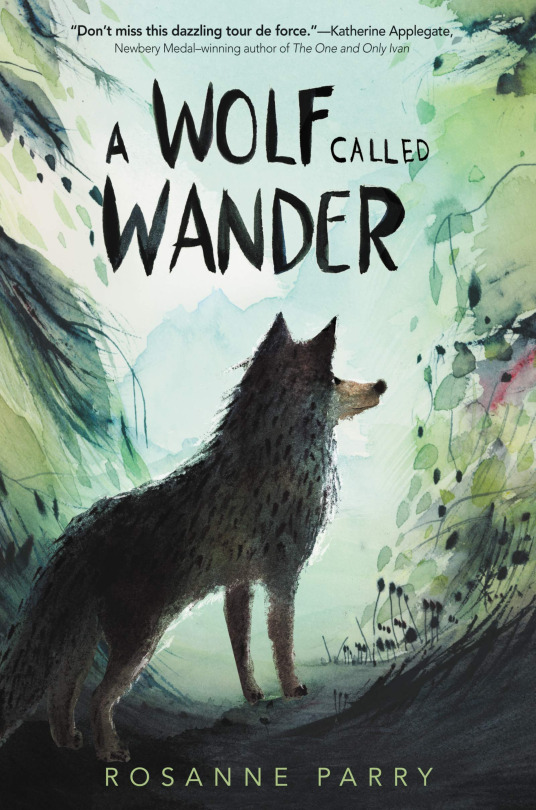
A Wolf Called Wander
A beautiful novel I had been hearing lots about. This story follows the young wolf Swift, who grows up knowing that he and his pack are the mountains, and the mountains are them. It’s in those mountains that he grows and learns and loves… until disaster strikes and he finds himself viciously torn apart from his family and forced out of the mountains that have always meant home to him. Forced to survive on his own. Swift then begins a gruelling journey that makes him face injury, starvation, and the everpresent danger of humans as he seeks a new place he can call home, and new people with whom he can form a pack.
This is all based on the true story of a tagged wolf known as OR-7, following the unbelievable route he took through Oregon and northern California! It was a very neat read, and I’d definitely recommend it if you enjoy stories told from an animal’s perspective because this book is a master class in it.
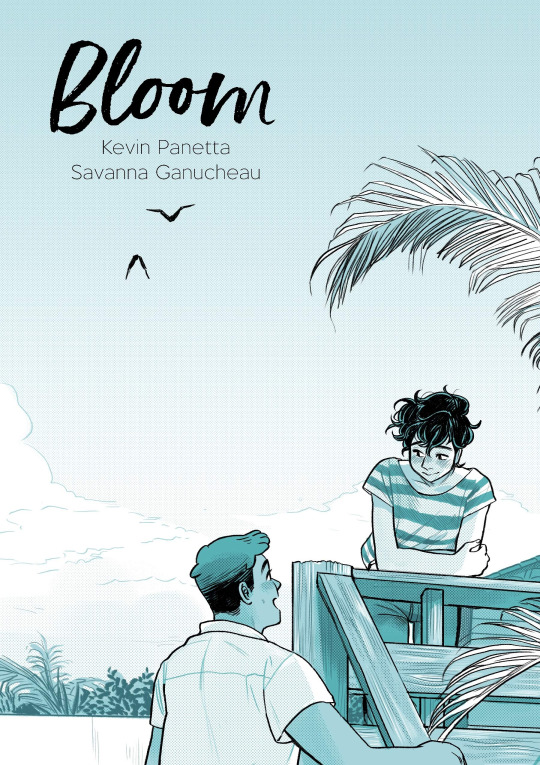
Bloom
I decided for June to try to read a handful of different queer books, and this was one of the first graphic novels I picked up. It is a super sweet story and the art is lovely. It’s about Ari, a boy who has just graduated high school and is now desperate to move away from his small town and his family’s struggling bakery, to join his band in the city where they hope to make it big. An agreement is finally reached: Ari’s father will let him leave, if he can find someone who can replace him in the bakery, which is how Ari meets Hector, someone who sees artistry and peace in baking. For anyone that’s read Check, Please, it gives off those types of vibes!

Boule et Bill: Bill est Maboul
Another book of Dupuis comics, because I can’t get enough of them! This one I just stumbled across and ended up reading on a whim but it was very cute. Geared younger than the others I’ve read, but still quite funny. It’s the charming hijinks of a young boy, his dog, and the family they live with. Each page or so is a different stand alone joke, a bit like Calvin and Hobbes except expanded beyond a single strip.

Chicken Run: Chicken Pies for the Soul
This was a ridiculous urge I got and had to follow. I recently rewatched Chicken Run (which is, of course, one of the best movies ever made) and felt the need to see if it had ever been novelized. Well, I found something better than a novelization! This is a chapter book with “advice” and stories written by the various characters, post-movie. It really does a good job with grasping the different characters’ voices and making something simple and funny out of it. It was very cute (and available on The Internet Archive if anyone else feels like reading something ridiculous!)
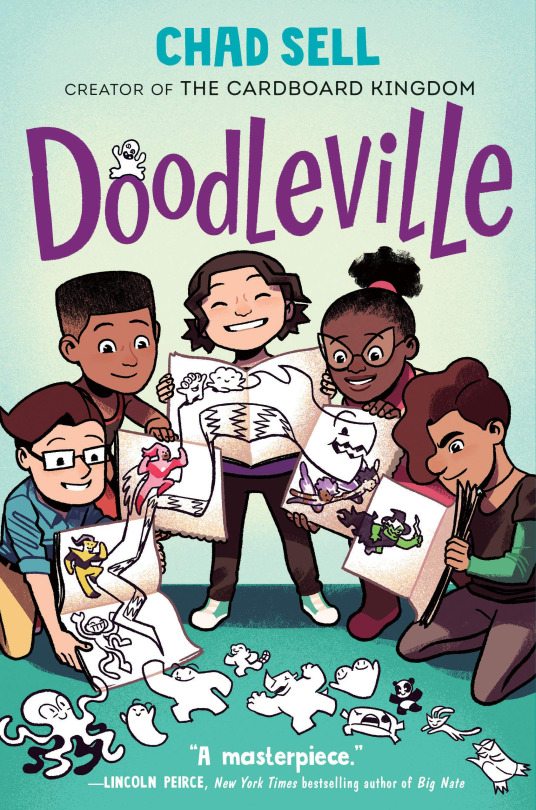
Doodleville
I picked this up on a whim and honestly, I shouldn’t have bothered. It was not very impressive. Very mediocre, awkward feeling artwork, and a story that only slightly manages to redeem it. The concept was kind of neat, and I did like how the ending came about, the rest was rather… plodding. I did not like the main character at all, her friends felt very Intentionally Quirky Aren’t We Cute :3 in a way that just tries too hard, and… yeah. Meh. It technically gets the “queer graphic novel flag” but it’s so in-passing that it feels rather excessive to give it that.
If you are interested, it’s about a world were doodles actually exist as living creatures that can be drawn into existence (the rather unsettling implications of which is never fully explored). This is all well and good, until the main character draws a monster and takes it with her to her art club... where it begins ravanging not only her doodles, but those of her friends. Together they need to work together to figure out how to stop this menace.
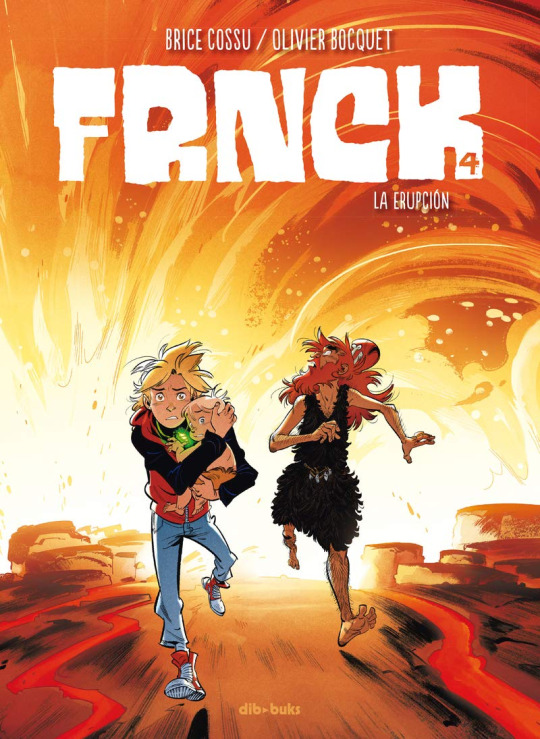
FRNCK v4
Phenomenal. I adore the FRNCK series, and book four wrapped up the first “cycle”, revealing several of the big secrets dogging the series so far, and changing how things are going to be able to run in the future.
If you haven’t seen me talk about it before, FRNCK is a graphic novel (a franco-belgian bande dessinée) about a young orphan, Franck, who’s chafing under the constant parade of uninterested foster parents that visit the orphanage he lives in. Determined to learn about his mysterious abandonment instead, he flees the orphanage… but finds himself tumbling through time, landing among a family of cave-people who rather reluctantly take him in and ensure this modern boy doesn’t die in the strange, dangerous new surroundings he finds himself in. You can get these ones in English as e-books, so if you want a really kickass graphic novel series to read please try these.
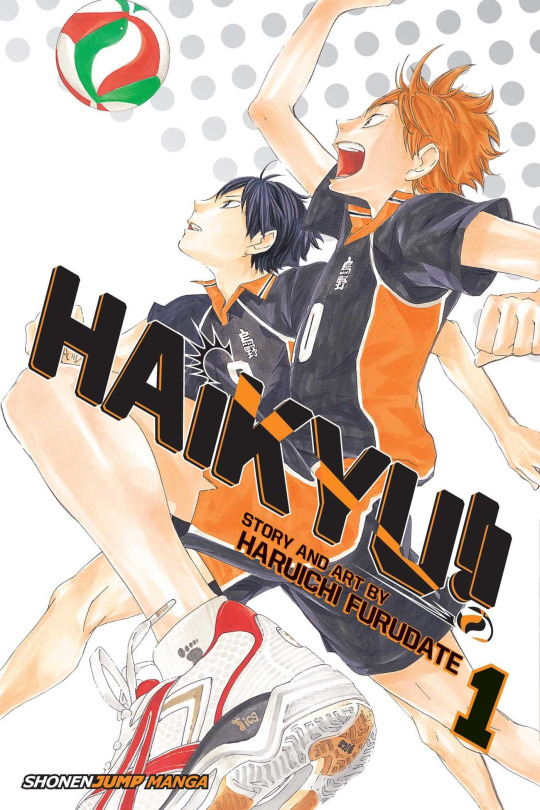
Haikyu!!
I’ve heard so much about Haikyu!! that I finally gave in and picked up the first book from the library. And I gotta say, it’s well worth the hype! This series really does capture the best parts of a good sports manga -- which is to say the team is filled with interesting, enjoyable character who all need to learn to pull together, boost each other’s strengths, and cover for each other’s weaknesses. Love me some found family tropes and this series oozes it in the best possible way. And then you also get some very cool action scenes as it makes high school volleyball seem like the most intense thing on earth. I can’t wait to continue it

Queer Eye
I haven’t been keeping up with Queer Eye but I was watching it ravenously when it first came out, and this seemed like a very cathartic book to read… and it really was. It had the same gentle, loving encouragement as the show. It doesn’t expect you to change your entire life, but to learn to embrace who you are, and take small steps to enhance those things. There a segment written (presumably) by each member of the Fab Five, explaining the mentality behind what they do on the show and how you can grow in those areas too. It’s very zen.
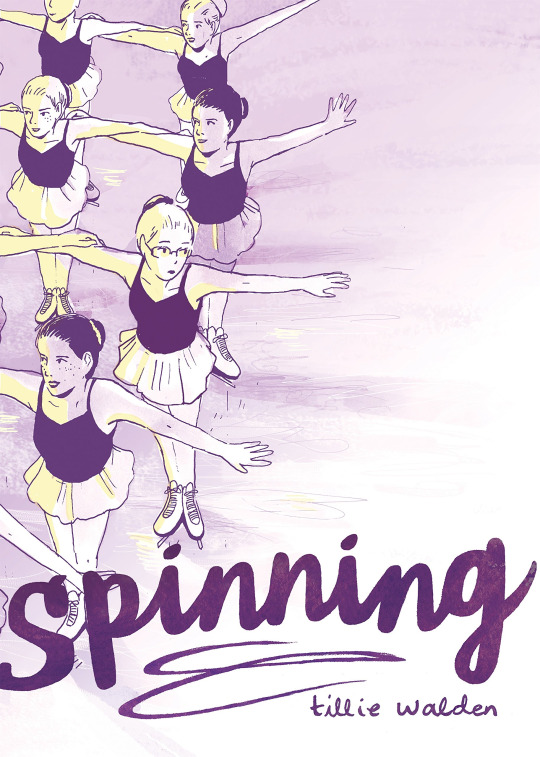
Spinning
I got this graphic novel out at the same time as Bloom, but it was the one that interested me less of the two... though that’s just because I have less interest in “real world” slice of life as a genre and this one is meant to be autobiographical. If you’re into that, you’ll probably love this because it really is stunning. Very pretty, and the format and pacing is all really well done. It’s a coming of age story for Tillie as she grows up dealing with a crosscountry move, complicated friendships, a burgeoning attraction to girls, and attending competitive figure skating classes.

This Place: 150 Years Retold
A stunning and heart-wrenching graphic novel told by a collection of different First Nation’s authors/artists, recounting oral histories about the 150 years since the colonialist formation of the country known as “Canada”. In other words, this is a post-apocalypse story, but one that really happened and that entire peoples are still fighting to survive. It’s very eye opening and beautifully told. Very strongly recommend the read, especially if you’re at all interested in history.

Torchwood: Serenity
Whoops, not technically a book. I had thought these were technically audiobooks at first, but rather they’re audio dramas that were played on the radio. Still, I decided to include one because I’ve been listening to them like a person possessed and they’re too fun not to at least mention. Let me indulge in my obsessions.
If you don’t know Torchwood, it’s a BBC series that spins-off from Doctor Who, focusing on the enigmatic and flirtatious Captain Jack Harkness, who is running the covert organization known as Torchwood, which is tasked to protect humanity from and prepare them for alien contact. It’s goofy and campy but also more adult and heavy than Doctor Who tends to get, so it is (in my opinion) a really fascinating series. Though it also has content warnings coming out the wazoo so maybe make sure it’s for you before delving in.
Serenity specifically is possibly one of the best Torchwood stories I’ve ever experienced. The Torchwood team concludes that there’s an undercover alien hiding in the idyllic gated community Serenity Plaza, and so that means it’s up to Jack and Ianto to go undercover as a happily married couple and flush out the alien without being discovered first. Even if it means being sickly sweet together, pretending to care about the local neighbourhood barbecues, and actually caring a bit too much about the Best Front Lawn competition. What is truly magical about this one, is that it manages to make it a Fake Dating AU despite the fact that Jack and Ianto are actually dating in canon. But they’re both used to dating as a pair of alien hunters with insanely dysfunctional lives, and who now need to figure out how to deal with domesticity. It is marvellous.
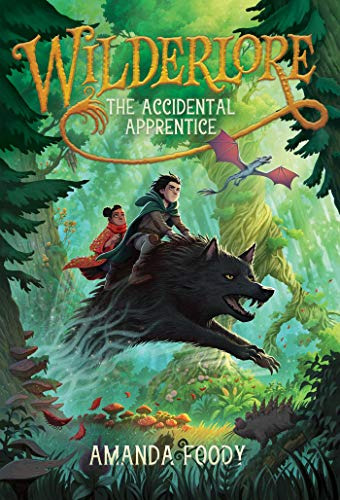
Wilderlore: The Accidental Apprentice
A middle grade novel that felt a bit like a cross between Harry Potter and Pokemon. It’s about orphan Barclay Thorne who wants nothing more than to be accepted in the rule-bound village of Dullshire, and live up to his apprenticeship as a mushroom farmer. He certainly wants nothing to do with the fearsome Beasts who live beyond the village, deep in the Woods or the sinister Lorekeepers that bond with them. It was, after all, a Beast that had killed his parents all those years ago. But when he finds himself at the very edge of the forest, hunting for an elusive mushroom, he is suddenly unable to avoid any of that. Not when a wild girl and her bonded dragon appear to summon a horrible Beast and end up getting Barclay bonded to it instead. Now, if Barclay ever wants to be welcomed back into his home, he has no choice but to venture into the Woods and find a way to sever the bond imprisoning him to the massive, monstrous wolf now imprinted on his body as a living tattoo.
I honestly can’t decide how I felt about this one. I feel like it’d be a really fun read for maybe a grade 5 to 7 student? I was a bit more meh about it. It was fine, but it was very hard not to draw unfavourable parallels to Harry Potter. But for a kid who’s never read Harry Potter? Or even an adult that has but is looking for something different to scratch that itch, this might be a good book to try. I’ll probably try reading the second book when it comes out.
#book review#book reviews#canlit#canadian literature#queer lit#queer books#pride month#wilderlore#torchwood serenity#this place: 150 years retold#cbc#spinning#tillie walden#amanda foody#queer eye#haikyu#haikyuu!!#furudate haruichi#frnck#dupuis#boule et bill#chicken run#bloom#kevin panetta#a wolf called wander#rosanne parry
26 notes
·
View notes
Text
Jeweler Richard Fanbook Short Story #2
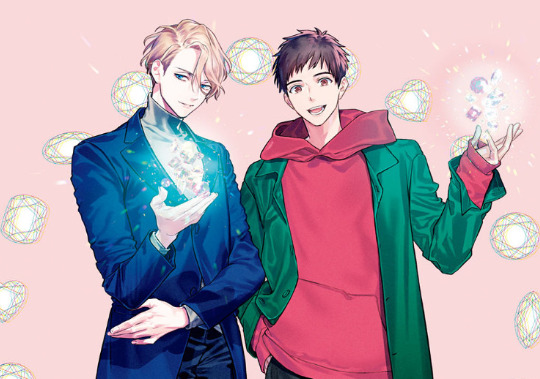
Feel free to message me about possible corrections, and please consider supporting the creators by purchasing digital copies of the official releases: Novel || Manga || Fanbook. In case anyone is feeling generous: Ko-fi | PayPal. ( ╹◡╹)っ’・*
← Previous || Index || Next →
Daily Life of Etranger: Professor Kunz and Morgan
Saturdays were long at Jewelry Etranger. We had a client scheduled to come by at four today. It was three-thirty in the afternoon. While on stand-by together with the shop manager, I felt like we still had a long wait ahead of us.
“Hey, Boss, why do stones always end with ‘nite’?”
Mr. Richard, the Englishman, reflected silently on the meaning of my question for a moment. Deep in thought, he had an elegant facial expression.
A few seconds later, Richard nodded with an “aah”. “What you are referring to is the naming of alexandrite, tanzanite, kunzite and others?”
“Yeah, yeah, that.”
“It is because of the ‘ITE’ suffix, right? Not that the names of all gemstones have it, but it is widely used to denote minerals. From the title of honor of the Romanov royal family, ‘Alexander’s Stone’, we have ‘alexandrite’. From ‘Tanzania’s Stone’, we have ‘tanzanite’. The latter is a commercial name given by a jewelry company, though.”
I get it; seems to be something like an alias.
“Then is kunzite also the name of a place called Kunz?”
“That one is the name of a person. It is named after a famous gemologist, Professor Kunz.”
So this one also received the suffix and became “kunzite”. I see; it’s pretty simple.
“Is that like the ‘sandwich’ in ‘Earl of Sandwich’? Was this Professor Kunz the person who discovered it?”
“Exactly. Good guess.”
Putting your own name on a stone. What was this feeling that someone could randomly stir up a romance with it? I did know that when people were granted naming rights when finding new stars or animals, but I see, that’s also valid for gems.
“So if I found one, it would be a nakatanite...?”
“Are you going to aim for the discovery of a new type of mineral?”
“Might be good! I could write in my resume that I’m ‘the Nakata who discovered the nakatanite’.”
“Pathetic. To think that your reason to be happy about discovering a new stone would be filling up a blank space on your resume...”
After that, Richard discussed that a new discovery meant expanding the scopes of science. That knowing about the existence of a stone that had a different structure from the already known minerals meant broadening the ranges of the world. Of course, an expansion of the jewelry world could also be useful for the development of the latest technology. The world of stones was unfathomable.
Since it was about a time where it wouldn’t be weird if the client showed up, I went to make today’s second serving of royal milk tea, and as I returned from the kitchenette to the reception room, Richard had opened his treasure box. There were two beautiful gemstones cozily lined up inside the large velvet box. One of the pink stones was tinged with a faint shade of lavender, while the other had a trace of orange. Both were very light colors.
“Those are pretty stones. What’re they called?”
“This is a kunzite. I was just stocking up on it.”
So that was the rumored one. With square-faceted cuts, both stones were about the size of half a pinky fingernail, emanating a shiny glow as they reflected the light.
“It is not very suitable to wear as everyday jewelry since it is a delicate stone, but it allows you to enjoy your day plenty enough. Collectors of rare stones are fond of it.”
“Is that kinda orange-ish one the same stone too?”
“This one is called morganite. They have a similar color but are different stones.”
“I’ll guess so don’t say it. Don’t say it no matter what. If kunzite is named after Professor Kunz, then this one... is named after Morgan-san?”
“Correct.”
I heard Richard’s “good for you” for the first time in a while. He spoke such an unfaltering Japanese that you could only think he was an actual Japanese man if you talked to him with your eyes closed, but his nationality was British and he was a blue-eyed blond. Just from his tongue-tying name, Richard Ranashinha de Vulpian, it didn’t seem like his origins were from England alone, but I didn’t know the details. Not yet.
“Aah, so this one was Professor Morgan’s discovery?”
“You were in the faculty of economics, right? Do you know the name and the bank J.P. Morgan?”
“Eh? I do. He was an American billionaire and founder of a big bank... Eh?”
A billionaire had been the discoverer of a mineral? Really?
As my eyes widened, Richard shook his head. “He was one of the world’s leading jewelry collectors. He was also a sponsor of the organization that Professor Kunz belonged to, and there was a deep liaison between the two. Kunzite was named after Professor Kunz, so for this one, they used Mr. Morgan’s name.”
“Heeh...”
Kunzite and morganite.
On one hand, there was the name of a gemologist who worked in the USA. He was surely famous in the world of stones, but if I hadn’t seen that gem, I likely wouldn’t have known his name for the rest of my life.
On the other hand, there was a financial king who had founded a huge company. Even I knew his name. But stones were stones.
Looking at them lined up on a velvet cushion like this, it sort of felt like I was also looking at two friends with similar tastes standing beside each other. Unlike stones, human beings had many kinds of titles clinging to them stickily, but in the end, we were all the same once we were stripped of them. Like “financial king”. “University student”. “Jeweler”. “English”.
“Hey, if I find two new types of stones in the future, I’ll name one ‘nakatanite’, but I’ll give the second one your name.”
Richard made an indescribable face. He did not take me seriously at all. That was expected. It was probably like discovering a new type of vegetable or fish. But there was no way that it didn’t exist.
“But how do you look for a new type of stone? Should I go find a mine that nobody knows about and get to digging it or something?”
“Unknown mines should still exist here and there even nowadays, but the planet called Earth is just one. Even in a place that has never been dug, if you analyze the soil of the area, you can have a rough idea of what kinds of stones are likely to come out of it. Rather than this, there have been several cases where people ‘discovered’ stones by proving that something people had been handling until recently as a different type of stone was actually a new type with a differing composition. Either way, a discernment backed by the knowledge of minerals and an analysis made through the required equipment is indispensable.”
“That’d turn into a pretty chemistry-centered story, huh?”
“Exactly. And of course, it would take time and money.”
“What a fleeting dream~”
“Great to see that you woke up from that dream. If you could find something by thinking of looking for it, nothing would ever be difficult.”
As Richard told me to put away the tea set, he took the flat jewelry box and returned to the backroom. It was 3:45 PM. The client had still not arrived. I washed the glasses in the kitchenette, somewhat unsatisfied, then went back again to the reception room. While the shopkeeper stood by the windowsill and stared down at the street, I called to him with a “hey”.
“Serious talk: between ‘richardite’, ‘ranashinhite’ and ‘devulpianite’, which do you prefer?”
Richard had good looks and was smart. The languages he spoke as if they were his mother tongue were not limited to Japanese. At the very least, speaking five to six idioms was a piece of cake for him. He knew about everything very well. He acted by thinking about ten times more thoroughly than me with a perspicacity more than ten times sharper than mine, so he didn’t make any imprudent blunders. I believed he could be working leisurely in a more secure, more advantageous and easier job. But he was working as a jeweler alone in Japan.
Which was why there was no mistake that the one behind that calm and composed face was quite a romanticist.
As I laughed with a “take it like I won the lottery”, Richard made a face of losing focus. “You mean to say I am your Morgan?”
“Now that you mentioned it, yeah. You’re the one paying my salary.”
“As for you, I think seiginite is better than nakatanite.”
“Eh?”
“If you were to name a stone,” Richard said. “Names are the only ‘garments’ that gemstones wear. I know that Nakata is quite a splendid name, but Seigi is more like you. I also feel that the benefits of wearing it would be easier to distinguish.”
“‘Benefits’, you say... like wanting to help people at random? That benefit’s a bit of a bother.”
“Not bad, is it?” saying so as he turned around, Richard smiled softly.
I wondered if that guy wasn’t actually doing minute calculations on when and in what way to smile, with a clear understanding of how to make the people around him feel good. I had a simple character, so I would end up getting extremely happy when I was told things like that. As I held back from grinning smugly, the beautiful storekeeper furrowed his brows.
“Anything wrong?”
“N-No, no, nothing.”
Shortly thereafter, the shop’s intercom rang. It was the scheduled appointment. The one who came in was a female costumer carrying several store bags – a collector of rare gems. She picked the loose kunzite and morganite, as well as two more rare stones, and went home highly satisfied. Richard had probably laid those stones in stock because he could predict that she was going to purchase them.
After closing the shop at five as usual and bidding goodbye to Richard at Sotobori Street, I remembered the talk we had left unfinished. It wasn’t because his smile was destructively beautiful or anything like that. Thinking logically, finding two new types of gemstone would be hard no matter how lucky I could be – no, one was already absurd –, so in any case, I wondered if “Richard and the Stone of Justice” would do. Dream stories were good, but if an English jeweler was saved by a Japanese university student and hired him to work part time for some reason, despite the low chances of something like that happening, I thought it would be great if I could do something of that level to surprise him. I was pretty serious about it.
#housekishou richard shi no nazo kantei#the case files of jeweler richard#jeweler richard#richard ranashinha de vulpian#nakata seigi#tsujimura nanako#richard#yukihiro utako#novel#my translation#jr short story collection
123 notes
·
View notes
Text
TPN History Theory
So chapter 141 finally gave as more info on the Promise from a 1000 years ago and ofc I couldn't help myself from geeking out in trying to correlate the new characters with historical figures!
The chapter said that the group of 6 working together included collaboration of different nations, and they are obviously mostly European in facial features and clothes. We don't know when exactly the promise was made, but a 1000 years ago should be around 1000-1050AD.
This was a turbulent time in European history, but the 6 biggest players in terms of nations were:
Kingdom of France (normans)
Kingdom of England (saxons)
Kingdom of Denmark (vikings)
Holy Roman Empire (germans, italians and czech)
Caliphate of Cordóba (spanish and north africans)
Byzantine Empire (greek, balkan and turk)
So based on cultures, here is my guess on how our new characters map out!
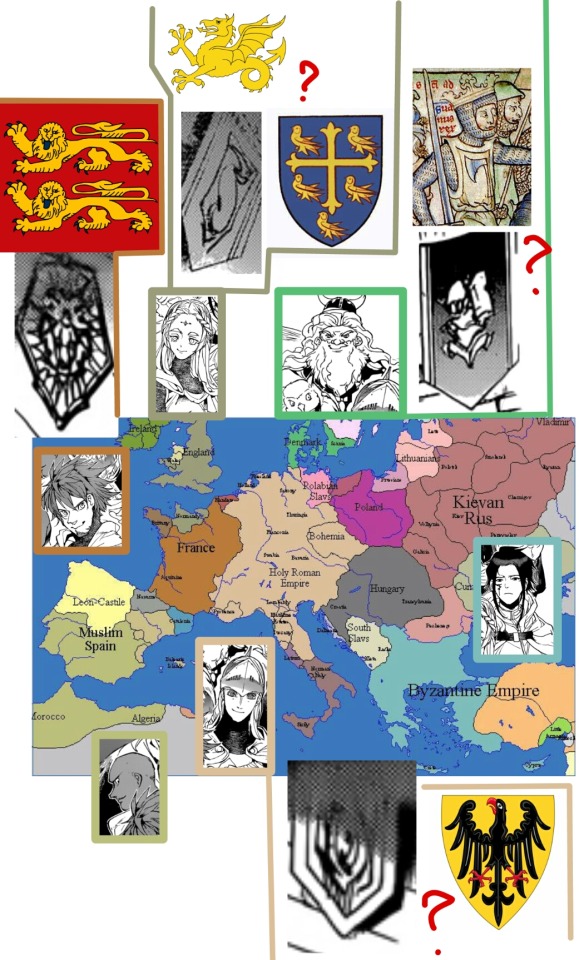
(Note that the Caliphate of Cordóba is labelled Muslim Spain on the map, also Normandy is the same colour as England because even though the normans were originally vassals of the French kingdom, they conquered England in the 2nd half of the 11th century...)
Okay, so let me explain how I arrived at my conclusions, and how the heraldry is related.
First off, I don't think Julius Ratri is based off of a real historical figure. Once the demon world was separated, he had to leave the human world to be the ambassador inside the demon world, so of course there would be no historical records of him.
Julius is most likely a nod to Julius Caesar, who was a great roman war leader and betrayed by his closest friends. He lived a 1000 years before the promise though, and it is most likely meant to be ironic that Julius Ratri unlike Caesar is the one to betray those closest to him...
I also think that his roman name implies an association with the Holy Roman Empire, which btw was an amalgam of nations ruled by a single, elected emperor legitimized by the Pope in Rome as the succesor to the original Roman Empire.
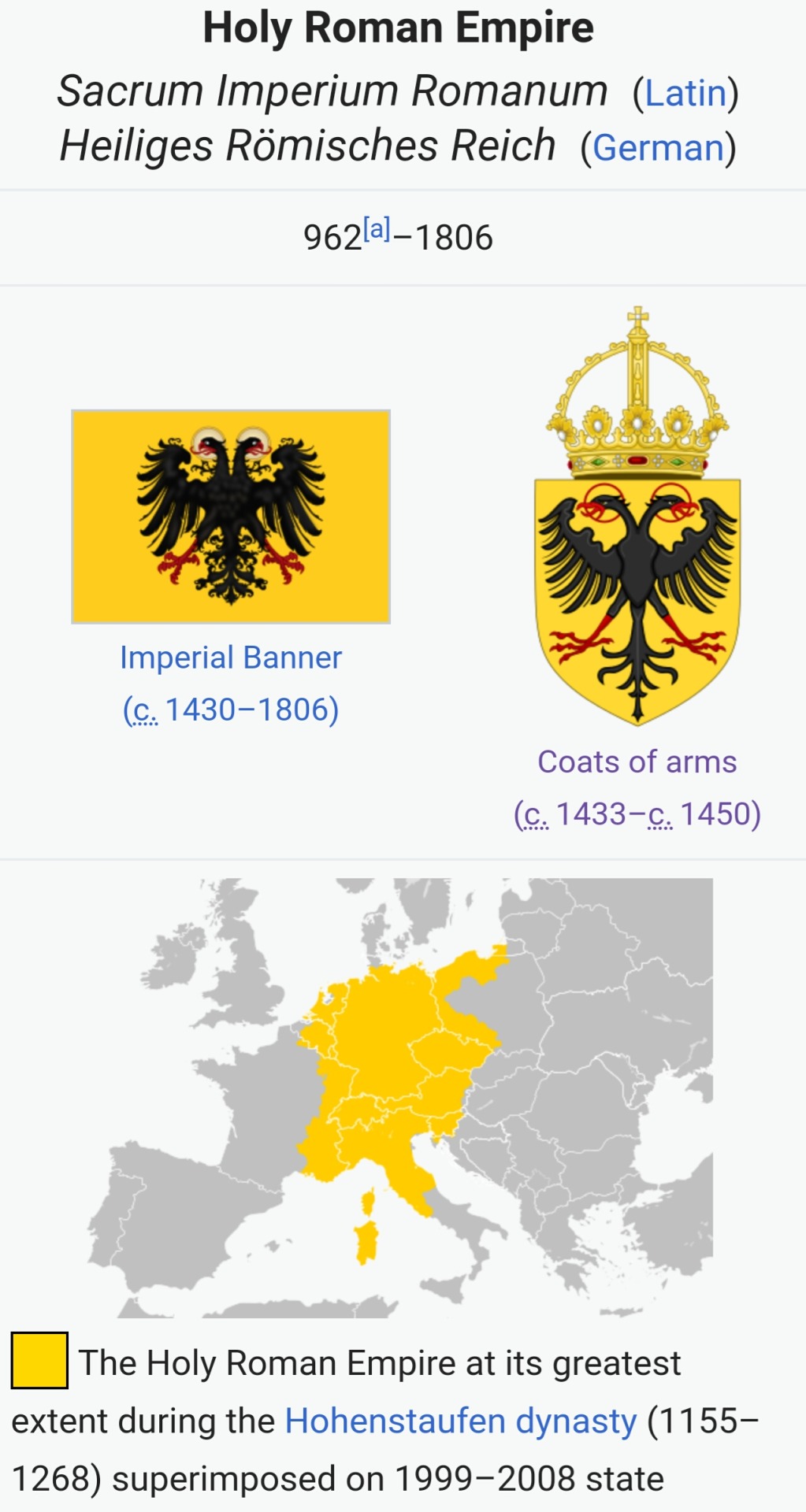
You may notice that a large part of the Holy Roman Empire were german, and tbh Julius does look like he could be german, and well, it is kind of a cliché that germans are the bad guys...
Now, if we are talking about Roman empires, we should mention that originally the succesor to the Roman Empire was recognised as the Byzantine Empire, which was a very wealthy and important nation for many centuries in Europe.
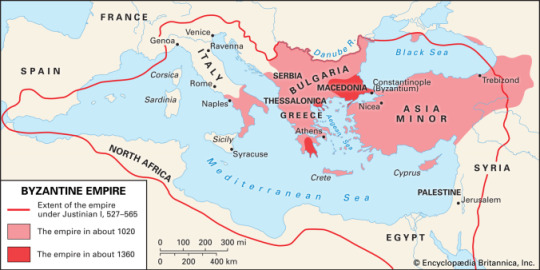
I was thinking that our black haired, Ray look-alike could represent this empire, as he/she clearly dresses differently to the Western European norms, and shows some asiatic features. He/she doesn't look far asian, like chinese, or even mongolian, so I think the Byzantine Empire is a much better fit.
It is a bit of wild guessing, but I think if they are male, they may be the emperor Basil II, or if they are female, they could be his niece, Zoe, who was briefly an empress. Not sure who else were important Byzantine Empire citizens!
Now looking at the genderbent Emma guy, he clearly looks like one of the fiercest warriors, and his crest seems to look like a lion. At the time in Europe, the most badass knights were the normans, so I am thinking he could potentially be a Duke of Normandy, and my guess is on Richard II "The Good".
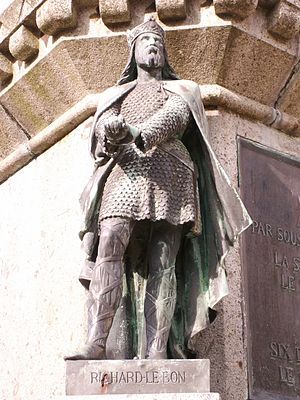
The Dukes of Normandy used gold lions on red as their heraldic symbols, and as I have said before, they were french in the first half of the 11th century. When they conquered England later, their descendants like the king Richard Lionheart, put the lion into the English royal crest.
Part of the reason however that the normans could successfully conquer England was that they had a claim to the throne by marriage! Richard II "The Good" had a sister, who he married to not only one, but two English kings, so she was actually queen of England twice (as well as the mother of multiple English kings).
This lady, who was the most influential and politically succesful woman of her time, and is one of the best known early medieval queens was Emma of Normandy.

So I am thinking that if our genderbent Norman is anyone historical, it would make a lot of sense for her to be Emma of Normandy. She seems to have a crest associated with her that looks kind of like a bird? Emma of Normandy didn't have a crest, but her husbands and sons had crests with either a wyvern or doves, that could maybe fit.
I have also previously theorised that it would be neat if Emma of Normandy was the mystery "Ratri" who forged the original promise with demon!God... and you know what I noticed? That genderbent Norman lady and Julius Ratri seems to be suspiciously close... could they be lovers?

Actually; looking at them, they kinda look like they how you would picture Norman's parents, if he had a happy family... and we know Norman looks almost identical to James Ratri, and very similar to Peter Ratri, so I think I may not be so off on these two having a child together that led to the Ratri clan. I am super excited if we also get an angsty love story out of it!
Btw I just noticed that Emma's original vision already showed us the two promises:
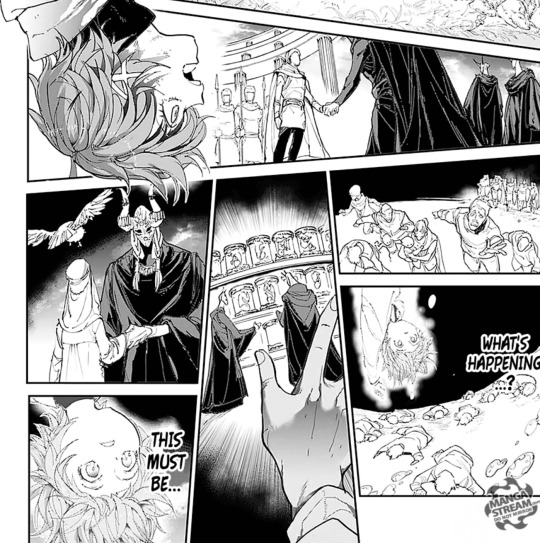
The top panel shows a warrior man, Julius shaking hands in public with a demon, who we now know is the demon king (not yet seen in the manga). We know that these two made a Promise between demon and human leaders.
The mid left panel shows a much more slender, female figure with a headscarf and a Ratri owl shake hands in private, with Lord Yverk. From the new chapter we know that these two made a different promise with demon!God.
So it looks like this is what Mujika meant when she said that there is more than one promises! I am eager to see the official translation of Ray discussing these in the flashback, because the current trans are a bit contradictory...
Either case, I am thinking that this mystery lady in the headscarf is either fem!Norman or the child of Julius and fem!Norman perhaps? I think she could have an owl either case.
I am still hoping this lady is Emma of Normandy, would be very poetic for our Emma then to reforge the promise. Either case, my guess is that she was either going behind Julius' back to create an alternative promise, or she directly opposed him to create a better solution! I think the second would be better drama in my opinion, and would also make Julius feel betrayed!

Speaking of turbulent times, so Emma of Normandy had to marry twice since her first husband was kind of beaten by the vikings, who temporarily conquered England (before the normans took it for good).
The viking king, who was also king of Denmark and Norway who achieved this was Sweyn Forkbeard. I thought it was fun that our TPN viking had a beard that was kind of "forked"...
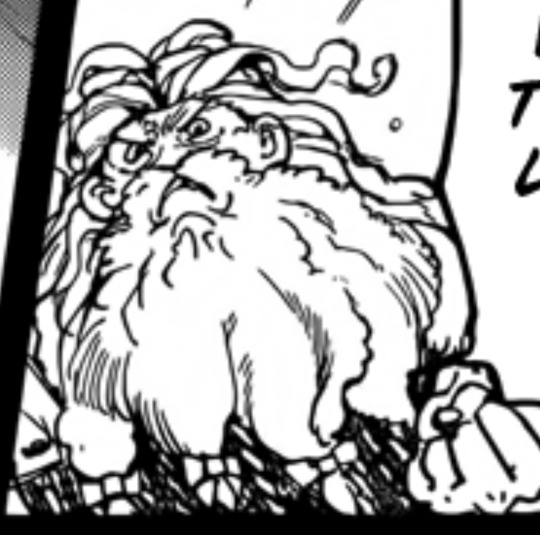
Even if he isn't Sweyn, there was a really famous warrior captain in his army called Thorkell the Tall, and we know this guy in TPN is also super tall. So it could be either of them! If it is Sweyn though, he was Emma of Normandy's father-in-law, albeit he died before she married his son.
As for the last person, who is the only person of colour, I think it would make sense for them to be from Muslim Spain. At the time, people of colour from that nation could travel Europe, and they were called the moors.
Unfortunately I don't know enough about the history of that area to guess well on who he could be. Let me know if anyone else has guesses!
Oh well, I can't wait to see how the rest of this history plays out. Looks like we will have some prime quality angst thanks to Julius!
#tpn spoilers#ynn#tpn#yakusoku no neverland#the promised neverland#emma of normandy#tpn history#tpn emma#tpn norman#tpn ray#genderbent trio#julius ratri
220 notes
·
View notes
Text
Death Note One-Shot Chapter Review
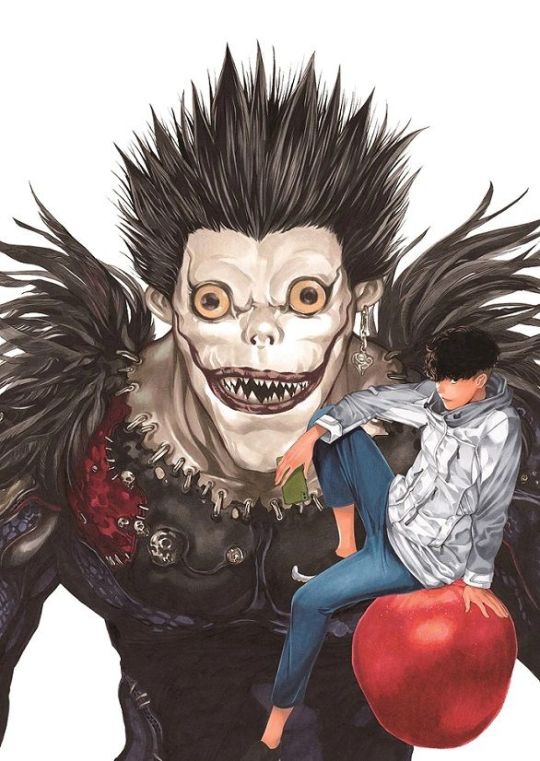
“AH! SHINIGAMI!” But in 2020!
By: Nay Holland
Death Note started off as a manga and anime series that joined others in its ilk during the 2000s renaissance. This was the time period that brought us many herald classics such as Naruto, Bleach, One Piece, Inuyasha, Full Metal Alchemist, and Gurren Lagann. I can spend the entire time naming at least ten other series that would either go on to have devoted fans over a decade later or continue in some form. Of course Naruto lives on through Boruto, rumors of a Bleach revival are on the way, and One Piece is, well, never ending at this point.
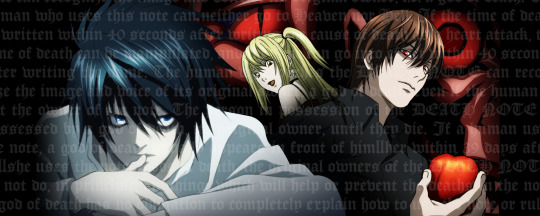
However, among the “Roaring 00s” of anime, Death Note always stood out to me. While I was invested in Naruto since middle school, I hadn’t touched Death Note until my high school years. During this time, the series was still popular, yet it always seemed overshadowed by the other bigger names. Despite this, it remains a huge hit in Japan with several live action movies, a prequel light novel, several dramas, and a TV series.
Of course, there was also the Netflix Original film which was an attempt to “Americanize” the series, for whatever reason. Back in 2017 it was a talking point, mostly how it didn’t live up to the source material presented. Nowadays, no one really talks about it and it is probably for the best.
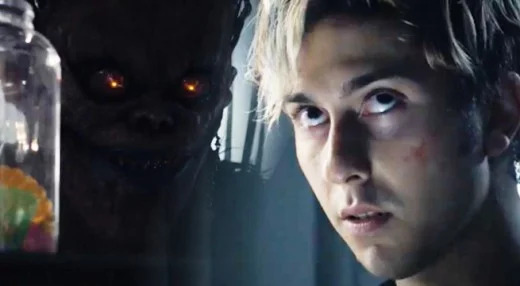
While Death Note is considered a cult classic in both the East and the West, it is no surprise that content is still being created to this day. The surprise factor stems from the unexpectant delivery of said content. On February 3rd 2020, the creators behind Death Note, author Tsugumi Ohba and artist Takeshi Obata, revisited the world that Kira left behind in a one-shot published by Viz Media.
While you don’t need to read the original manga to read the one-shot, the one-shot will assume you know the original source as many existing characters, themes, and events from the original manga are all featured within the chapter. That said, it will greatly enhance the experience if you know the source material. Past this point there will be spoilers on the original manga and the one-shot chapter as I’ll be referring to both.
This isn’t the first “one-shot” within the Death Note universe. The first official one-shot dates as far back as 2008, two years after the original series was completed. Set three years after Kira’s death, this one-shot focused on a new “Kira.” This “Kira” has access to the Death Note via a shinigami (who wasn’t Ryuk) and used it to murder those who had a low life expectancy. However, the new “L,” formerly known as Near, quickly shuts his antics down. The new “Kira” then uses the Death Note to kill himself and the shinigami retrieve the book.

Before we can discuss the latest one-shot, we first have to discuss Takeshi Obata’s art exhibit that was held in the Summer of 2019; Never Complete.
Never Complete was an art exhibit celebrating Obata’s thirty-years as a manga artist. Within the exhibit, many of his previous works from Hikaru no Go, Bakuman, Death Note, and the latest ongoing series, Platinum End were all on display.

Bonus content which included first drafts of illustrations, were also featured. Among the bonus content, the most peculiar one was a storyboard draft of the 87-page one-shot. The storyboard draft can be seen and read in almost its entirety on the official Shonen Jump Plus website. Six months later, we have an official release in both Japanese and English. The official English translation can be viewed here.
Our story begins right where the previous one-shot left off. The shinigami who wasn’t Ryuk, gives Ryuk back the Death Note, claiming he was unsuccessful while also giving him an apple as an offering. Being bored of the shinigami world as well as a craving for more apples, Ryuk sets off to see who could be the successor of the Death Note. If it entails free apples, Ryuk ain’t complaining.
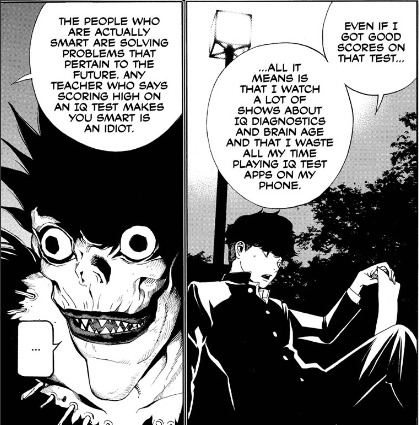
We then get to meet a young Minoru Tanaka, a middle schooler who is known for having the highest test grades in the region. When Ryuk introduces himself to Tanaka, the only thing Ryuk knows is that Tanaka is smart in school, comparing Minoru Tanaka to Light Yagami’s aptitude in school.
However, his actual grades are mediocre at best. This already contrasts Light who was a certified genius both in tests as well as grades. As Tanaka explains that his ability to score high on tests are dependent on his knowledge of IQ tests and quizzes, he bemoans that adults who see grades yet fail to see the bigger picture are no better.
As Tanaka holds the Death Note in his hand, all he knows is that it was once Kira’s. It is during this scene that we learn the state of Tokyo after Kira’s death, ten years later. Yagami’s legacy lives on as he is taught in schools around Tokyo. Tanaka exclaims that he was taught about him in Ethics class and in World History class, both of whom consider him to be an evil mass-murdering sociopath that placed Tokyo on the brink of destruction.

There’s just one problem with holding the single most powerful and dangerous weapon in the world. What good is a Death Note if you can’t even read its instructions?
While this wasn’t a problem for Light as he was a genius who understood fluent English and Japanese, here was a middle schooler who struggled with English. He asks Ryuk to translate the English into Japanese, just so that he can understand how to use it.
However, while not as academically bright as Light, Minoru is more logical with his approach. He understands how the Death Note was used in the past. The major difference between the past and the present are the increase in security measures to ensure a repeat of what happened doesn’t transpire again. When Ryuk asks if Minoru can use the Death Note the same way that Kira did, Minoru hesitates.
Knowing the state of Tokyo right now as well as knowing the history of Kira and the Death Note, he has no interest or intentions of using the Death Note for similar deeds. Here lies a normal child who excels at critical thinking who has the opportunity of a lifetime.
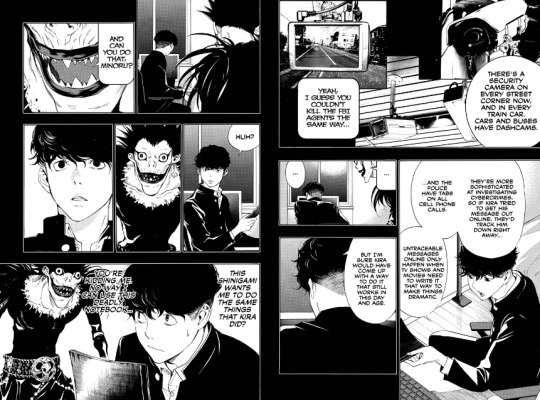
Those who don’t learn from history are doomed to repeat it. He also can’t risk the book falling into the hands of someone else who would use the book for the same reasons Kira did, or worse. So he does the one thing that he could do in this situation. He buys himself two years of time. He tells Ryuk to come back to him in two years, while asking him two critical questions.
The first question he asks is if it was possible for those who touched the notebook to still see Ryuk. This would involve the former Investigation Team and Near, who brought Kira to justice.
The second question was how far can Ryuk move around without being close to Minoru. This comes into play two years later when Minoru decides to ultimately sell the Death Note.
That’s right. He sells the Death Note.
But not just to anyone, especially not via Craigslist either.
Conveniently, the TV broadcast station is close by Tanaka’s house. With a pen and paper he tells Ryuk to write a message that will incur interest without actually having to directly contact Tanaka himself. Since the net and all of its usage can be easily tracked, using the TV to broadcast the message provides a safe approach for Tanaka to cover his trail. Rather, you can’t cover a trail you never create.
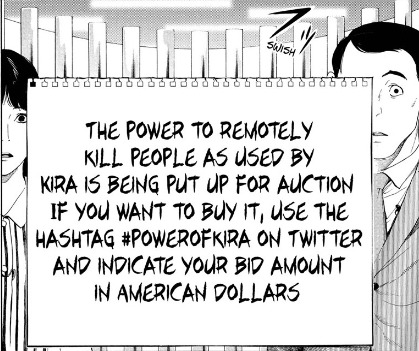
Conversely, those who had seen Ryuk from ten years ago, were able to see Ryuk on television. This introduces several key characters from the original series into the one-shot. The first is Matsuda, who is every bit as hot headed and foolishly passionate in the present as he was in the past.
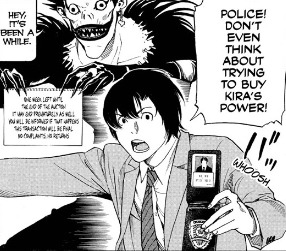
The second, is L.
Not the L we know, but, the current L. Near.
Fragments of the iconic “L vs Kira” fight start to show over the next few pages as the bids for the Death Note reaches into the trillions and L continuously wondering how things are playing out. He understands that the “Auction Kira” or “A-Kira” is playing a very cautious game, but fails to see the endgame.

As the bid for the Death Note reaches record highs, it is revealed that the two nations bidding for the Death Note are none other than…
...The United States of America…
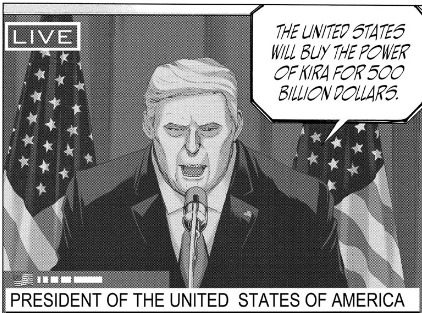
...And China….
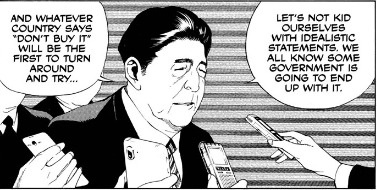
Despite two of the largest world leaders in the hot seat bidding on the Death Note, Minoru is unphased. In the end, the USA wins the auction. At this point, Near awaits to figure out just how “A-Kira” is going to attain the money. Thinking this through, Minoru demands payment in such a way that it is almost impossible to be tracked down.
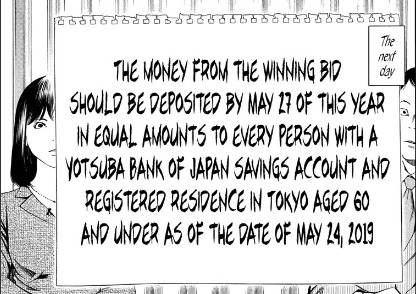
Within this time period, it is enough for Tanaka to relinquish ownership of the Death Note, forget he had it, and live a peaceful life along with millions of others in Japan. Given the circumstances and how millions will have access to such money, as well as the owner of the Death Note forgetting he had the Death Note, Near backs off, admitting defeat.

There is one fatal flaw to Tanaka’s entire plan and it was a flaw that would lead to his death.
Turns out Tanaka was so smart that not only did he outsmart the smartest human alive, but he also outsmarted the Shinigami King himself. Shortly before the Death Note was relinquished, the King ordered Ryuk to write a new rule within the Death Note. The rule being this.

With even the Shinigami King being upset that the Death Note was allowed to be sold to another, this new rule ensured that Tanaka was going to die a month from now. The president, however, chose to relinquish ownership, but declares that he has the power of Kira to herald his power over everyone else.
So, as stated in the new ruling of the Death Note, Tanaka’s name was written in Ryuk’s Death Note as soon as he received the money and the chapter ends on that note.

The first thing I want to mention is that Tanaka was too smart for his own good. Kira’s downfall was that his God complex forced him to become disillusioned. Tanaka’s downfall was the complete opposite. He felt his plan was entirely foolproof without taking into the variable of the shinigami lowballing him.
This reminded me of the time when Rem declared that she would kill Light if he ever caused the death or harm of Misa. At this point this was Light’s first interaction with another shinigami. Knowing who Rem was and the type of person she was, he was able to manipulate her to his livelihood by sacrificing herself. Tanaka never got to see the Shinigami King himself, and the King made sure of it.
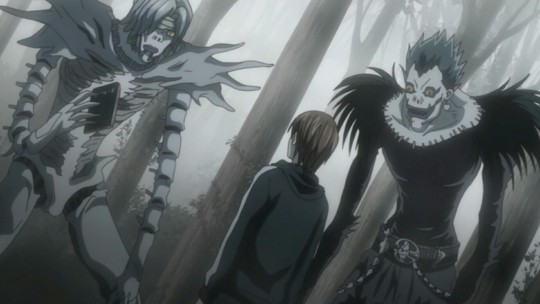
Tanaka not only never met another shinigami so he could understand how they would behave, but he also never met Near---I mean L. I gotta stop calling him Near.
He never got to meet L, he never got to meet the investigation team. All of Tanaka’s actions were met through the safety of his room. This was beneficial as he was able to cover his tracks, but it proved his downfall as he followed a plan from start to finish without thinking of the variables.
The moment Tanaka relinquished ownership, his fate was sealed. Tanaka wouldn’t have known about the rule change and it wouldn’t be up to Ryuk to remind him. Ryuk is many things, but Ryuk is a shinigami of his words.
It’s because of Ryuk being a shinigami of his word that proved to be fatal to Light as well. From the beginning of Light’s reign into Kira, Ryuk promised that if Light were to ever put himself in a situation where Light would die, Ryuk would write his name in the Death Note.
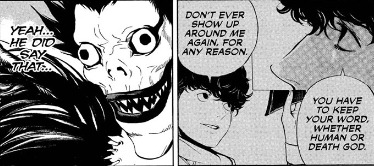
Ryuk never had the chance to warn Tanaka about the rule change as he was told never to show his face again. Thus, Tanaka died oblivious to anything that he had done, unlike Light who died knowing all of the things he’d done.
The final thing I want to reflect upon is the concept of legacy. Throughout the chapter we’re told about the lasting impression Kira had on not just Japan, but the entire world. It was this legacy that spurred the interest of ownership of the Death Note to begin with. Even if the Death Note was never used, the fact that it could be used to incite fear and dominance among one’s nation and the world is enough for anyone in a position of power.

The caveat of covering your path is that no one knows your name. This was the entire point of Tanaka’s ownership of the Death Note. He wanted to get rid of it while also making a profit off of it. If all of Japan would reap the benefits of the Death Note, then it was just a bonus.
His mother wouldn’t struggle, his family wouldn’t struggle, everyone would be set for life. This one child single-handedly caused an entire economic bubble and yet his legacy would be left behind with no one knowing who he was.
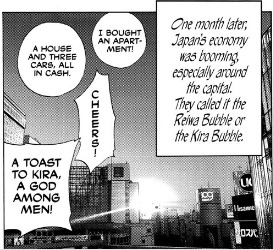
If you’re a fan of the series, I highly recommend giving this a read. In fact it makes me want to revisit the series one more time. It was nice seeing how my old favorites were doing ten years later, both literally and within universe. It was also a good read that, much like the original Death Note, left a lot to think about as far as current events.
The timing of the release of this chapter, the realistic physical details of the world leaders for USA and China, and the themes shared within the chapter are non-coincidental I believe. While a Death Note is obviously fantasy, it reads itself like a parody of modern-day politics. A caricature of the lengths those in power would go to obtain a destructive instrument used for intimidation purposes.
Unfortunately, even if you do everything in your power to just live a peaceful life, in the words of Ryuk…
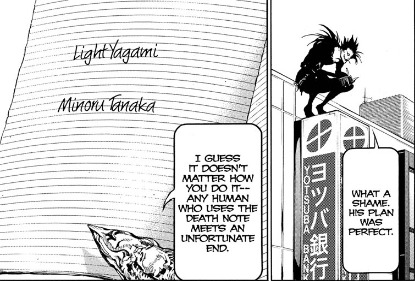
2 notes
·
View notes
Note
If you could appoint another hokage other than naruto, who are a few suitors that you have in mind?
Ooof, that’s a complicated one.
I mentioned in another ask (I think it’s again the ask about my ultimative ending for Naruto), that the decision to place Kakashi before Naruto as the Hokage was the right one. Sure, Tsunade also could’ve continued as the leader of Konoha, but when you’re done, you’re done.
But another Hokage as Naruto? I don’t think there would be a candidate for this.
Kakashi was the Sixth, and as shown in the manga/anime, he really doesn’t want to be Hokage. He has this “Okay, I will do it if I have to, but only with a lot of reluctance.” kind of stance. Because that’s that the village needs him to be, first when Tsunade fell into her coma and to avoid Danzo’s candidature, second because Naruto needed time to learn everything necessary to prepare for his dreamposition.
Is there another adult jonin with the same or similar kind of score which would be fitting to not only stand at the top of Konoha and defend the village if needed, but also represent Konohagakure as a political force? Asuma would’ve been my next choice, alone because of his connection to the Third Hokage, his position as one of the Twelve Shinobi Guardians, and also his levelheaded thinking as seen in the fight with Hidan and Kakuzu. Next thing would be obviously his fighting power, which wasn’t quite up to par with other Hokage’s such as his father, who was apparently a well-known and powerful shinobi, before he became a douchebag who doesn’t know how to handle traumatized children. (When I really think about it, Hiruzen also didn’t have a great connection with his own son… So he always sucked with young children? But what about Iruka? T^T I’m confused.)
Kurenai is unfortunately out due to her pregnancy and also has not as much of experience as Kakashi, as she was younger than both Kakashi and Asuma. Gai would be another choice, but representing the Leaf? … Yeah, he’s a good fighter, but couldn’t get some of the polotical nuances right (even though that’s not the most important thing, but still important enough. Does understand anyone what I mean? T^T) The rest of the characters which come to my mind, are simply not strong enough to be the Hokage, such as Iruka, Kotetsu and Izumo. A special case would be Yamato. His power of having the Wood Kekkei Genkai of the First Hokage would be interesting as a display of strength of the Leaf, but due to the fact that this power is not entirely his own, he has spent a big majority of his life in Anbu and Anbu Roots and that he’s also a product of Orochimaru, who’s a sought war criminal in several countries due to his attack during the chunin exams and his experiments, I don’t think he would be a wise choice. Other nations could constantly question him and his abilities, his loyalty to the village when everything he owns is basically due to Orochimaru and Danzo’s training (who also tried to manipulate all the other Kage with a stolen Sharingan… Questionable choices he also surely taught to his subordinates.) Anko is also dismissed because of the same reason, her affiliation to Orochimaru is even stronger than Yamato’s, because she actually went after him and was his student. The other adult shinobi I can think of are clanheads and already in other positions (Like Hiashi Hyuuga, Choza Akimichi, Ibiki Morino,
Now, we can take a look at the younger generation of the Konoha 12. All very powerful shinobi, without a doubt, but also pretty young. So, which ones stand out a little bit more than the rest in terms of battle power and social and political knowledge?
Shikamaru
He would be the first on to be named. But due to the fact that he really doesn’t want to be Hokage and is unlike Kakashi not willing to make any kind of compromise, nobody can force him into this position. Also, he may be strong and intelligent, but in terms of raw strength loses against the other three mentioned.
Sasuke
Well, oh well… Our favorite Uchiha. Or not-favorite Uchiha, depends on your own opinion. He may be strong, but he was a big fat rogue, killed the stand-in Hokage Danzo, tried to kill the other Hokage at the summit, collaborated with Orochimaru, was part of Akatsuki, kidnapped Killer Bee and the Hachibi, cut off the Raikage’s arm… Yeah… He commited too many crimes to be taken as a serious candidate for the Hokage title.
Sakura
So, what about Sakura? She’s a student of Tsunade, saved the world from Kaguya, can heal and fight alongside her comrades just like her teacher, is basically a carbon copy from Tsunade, only that her chakra control is even better than Tsunade’s. She also has the emotional stability and sense for politics, is bright-minded and certainly more level-headed than Naruto. So, what is speaking against her?
And last, but not least, Naruto. He’s the savior of the world, the incarnation of the sun, etcetc blablabla. We know that, we know why he was being selected, no explanation needed. No questions asked. Due to his position in the middle of everything (fighting against Tobi, fighting against Madara, fighting against Kaguya and everything), with his mind of “changing the world and breaking through the circle of hate and injuring each other”, he was THE hottest nomination. After several wars in the timespan of only two decades I believe, the people probably needed someone like him, who would actively go against more wars and battles between the shinobi villages.
Due to Shikamaru’s “I will be the second hand, but not the Hokage”, just like his dad has been and Sasuke’s streak of “I kill everything what stands in my way and burn down Konohagakure while I’m at it”, only Sakura and Naruto are left. So, why not Sakura (from my opinion) for Hokage? Well, because she’s through and through her teacher’s student. She’s a carbon copy of Tsunade, who also didn’t want to be Hokage at first and had to be talked into it by Jirayia and Naruto. Yes, she is stronger and probably has a better chakra control, but I whole-heartedly believe she prefers to stay in the hospital to help people directly, instead of going through apparently endless amounts of paperwork, sending teams on missions they probably never return from, etc. She can watch how her helping hand is recognized directly in the hospital, instead of pushing through reforms and laws and orders like her teacher did.
And in the end, it also boils down to “Who wants it most?” and there is no other person who wants it more than Naruto. I think we can all agree on that. After all of his efforts he put into his goal, the training and the sacrifices and experiences, his achievements and strength, he’s at the end, the most logical choice, especially after he saved the world. He went into the war and changed the tide of the battles with his distribution of Kurama’s chakra, gave his emotional speeches and so on and so on. He has the civilians on his side, he has several other Kage on his side, he has the majority of his own village on his side. If no one would give him the Hokage title, they would fucking riot. The only reason why he wasn’t it given immediately after the war was the fact that he had to learn some manners and politics in order to have the necessary knowledge to properly make calls and decisions.

So, yeah. I think actually really that Sakura could’ve been a legitimate candidate (unpopular opinion probably) but because her “opponent” in this case was Naruto, in a direct comparison she has to lose. Also, otherwise, there was also no other person to do the job, who wanted to be the Hokage and reform the system, so…
That is my answer. I hope it’s halfway logical and makes some sense ^^’‘
5 notes
·
View notes
Text
Mental Disorder Analysis of Killing Stalking
I did a bit of a project (for school) here where I analyze the actions in Killing Stalking from the perspective that Yoon Bum and Oh Sangwoo are mentally ill individuals. I attempt here to explain and defend the characters, as well as try to educate the fandom to alleviate hate rooted from ignorance. I’ll share a preview tand then add the rest under a read more bar; I went a tad overboard.
So maybe you’re a fan of Killing Stalking. Maybe you’re an anti. Maybe you’re a closet fan who’s ashamed to admit having a liking for the manga. For me, upon my first interaction with the fandom, I’ll admit it, I was nearly repulsed, but I’ve come a long way since that time and become an active member in the fandom, and even cosplay! After some consideration, I’ve realized the themes presented here aren’t much different from any crime-themed tv show, like Criminal Minds or something similar. Then I began to question myself and why I was even an anti to start off with, and the answer to that boiled down to ignorance. Upon a first glance, it isn’t hard not to view this simply as a toxic relationship that gets its readers off on some BL sadomasochism about a killer and, who I assumed at the time to be a kidnapped boy, who gets tortured. That’s simply not what this manga is, and it’s belittling to pass it off as much. If you know of killing stalking, you can bypass the next paragraph, but through my little ramblings here I’m hoping to defend this manga for what it is and to explain to you all (whether you’re a fan or an anti) some realistic reasonings for the actions/reactions of these characters centered around some potential mental illnesses here at play. The creator and these boys need some defending in this fandom, and so do us fans (who some of you, like me, I’m sure have been told we’re gross, need to kill ourselves, etc. We deserve more credit 😉 )
Killing Stalking is a psychological thriller manga with one protagonist being a stalker, and the other a killer, as the name suggests. Our first protagonist, Yoonbum, is a man in his late twenties who stalks his crush Oh Sangwoo, who he met in the military and later during his time in college. Yoonbm excessively follows his crush on social media and spends months trying to unlock Sangwoo’s house passcode. Upon entering the code correctly, Bum enters the home, where he discovers a naked woman bound and gagged, struggling to free herself. Panicked, Bum tries to help, but is then found by Sangwoo, and confesses his love before being pushed down the stairs, knocked unconscious, and later wakes with broken legs. Rather than ending Bum’s life, Sangwoo spares his life, keeping him in the basement for some time before allowing him upstairs, and eventually out of the house, though he’s kept close. As the story progresses, the two characters, in my way of seeing, develop a sort of symbiotic relationship with each other. Bum feeding off of his theorized love with Sangwoo, and Sangwoo feeding off the power he has over Bum. Thinking about it; these two need each other.
Now the above mentioned point, the theory of their symbiotic relationship, is often the basis for the fans to send their ships sailing, thinking, “clearly their in love”. Sure, why not, Sangwoo spares Bum’s life but murders others, treats his wounds, kisses him, and Bum still pines for Sangwoo and tries to please him, not to mention their physical moments together, but a story this deep deserves a deeper insight. Plus, the author herself said she hasn’t intended their relationship to be viewed as romantic. So instead, through my rather messy thoughts, maybe I can guide you into your start of deeper thinking based on real life mental disorders that should be considered here. This explanation should help you realize why Sangwoo and Bum’s relationship isn’t simple enough to be viewed as “traditionally romantic” but also I really wish to address fan’s individual outlooks on these characters and defend their characters for what they’re written as: mentally ill (I’m not knocking shippers here; ship what you want. I myself ship their theoretical existence, though I understand in canon it can’t be viewed that simply).

To begin, the words Borderline Personality Disorder (BPD) appear in the first season of the manga, already giving insight to one of the disorders that Bum possess. Though I plan to cover a few disorders in this post, for the sake of my analysis I’ll be showing evidence for BPD as well as psychosis at the same time, as psychosis is a symptom versus an illness. Many people with BPD have the symptom of psychosis (psychforums.com), and in the case of Yoon Bum, I believe this to be true. For starters, according to the National Institute of Mental Health, BPD is defined as “a mental illness marked by an ongoing pattern of varying moods, self-image, and behavior” with symptoms such as impulsive behaviors, self-harming behaviors, problems controlling anger, feelings of dissociation, and a distorted/unstable image of oneself (NIMH). Psychosis then is a delusional disorder, characterized as disruptions to a person’s thoughts and perceptions that make it difficult for them to recognize what is real and what isn’t. Found from a discussion online, it isn’t common for stalkers to suffer from psychosis (aminoapps.com). Though right off the bat you may recognize Bum as possessing qualities from both of these, I’d like t point out too that for those who have BPD, it isn’t uncommon for them to have a favorite person (FP), which in Bum’s case would be Sangwoo.
Looking at BPD from the standpoint of someone who suffers with the disorder, one person reports having issues with obsessing over people, “almost to the point of stalking them” (medhelp.org), and in relation to how someone with the disorder views an FP, their FP is their everything. To quote someone that this applies to, having an FP is “dangerous. It’s needing someone so bad it’s physically painful when they leave. It’s apologizing for every tiny thing because you don’t want to give them a reason to leave you (TheMighty.com), or “[that FP] is sometimes all I can think about. Male or female. I think about them 24/7 romantically or like a friend, but that person just becomes so perfect and put on a pedestal” (medhelp.org). The above quotes can all sympathize with Bum, especially if we’re choosing to look at Sangwoo as his FP. From chapter one, we’re shown that Bum obsessives over Sangwoo; stalks his social media, watches him on the train, and even fantasizes about him sexually, wondering “how he would have sex”. Through internal monologue we see how Bum views him; perfect, while noting “his empathetic, considerate, gentle aura”. Even after being hit by Sangwoo, he recalls his perfect image of his crush, noting, “The Sangwoo I know is a much more considerate person.”
Because those with Borderline Personality Disorder have troubles or inabilities regulating their emotions, Bum has a hard time maintaining his image of Sangwoo and is often caught having many back and forth emotions. He’s caught up on his love one moment, and during the next, he’s trying to convince himself that he hates him. Of course, things get harder on Bum when we realize that Sangwoo too is emotionally unstable, but we’ll talk about him later on.


For those with BPD, “relationships build quickly and intensely. They are unable to see the faults of their partner” (borderline-personality-disorder.com). This isn’t surprising; Bum’s always had troubles seeing the faults in his crush. Even upon discovering Sangwoo was a murderer, he apologizes, realizing he’s upset him, and takes blame for the situation. He resorts back to his idealized image of Sangwoo after remembering the reasons that he fell in love with him, claiming to love him despite the current situation he’s in. Not only that but he even confessed repeatedly to liking Sangwoo as he’s being assaulted, calling out, “I like you” over and over even as Sangwoo shouts at him to shut up. He’s unable, in many situations to see the faults that Sangwoo has (even though Sangwoo’s faults are pretty extreme). Recall too Bum questioning the police, asking “could you kiss somebody like me? Could you love somebody like me?”, etc. To him, he doesn’t view himself to be likable by anyone but Sangwoo, as he truly believes that Sangwoo has feelings for him.
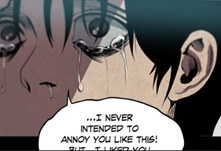
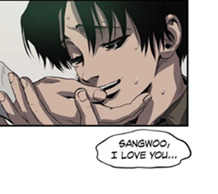
If, as I suspect, Bum also suffers from psychosis, his inability to regulate his feelings for Sangwoo could be amplified. This could explain why he can’t quite rationalize what is real about their relationship and what isn’t (or any of his relationships, for that matter). Below, remember when he was under the impression that him and his female classmate were dating when she removed her shirt in front of him? And then he believed that all along he and Sangwoo were dating when Sangwoo said such a thing to the police.
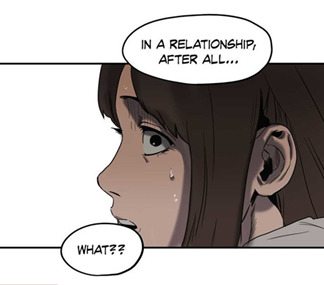

Psychosis in Bum’s case not only prevents him from knowing what reality is in terms of his relationships with others, but it also alters his perception of the reality surrounding him. Psychosis can cause hallucinations and delusions. Hallucinations aren’t new to him, just recall the hallucination of dead bodies in Sangwoo’s washing machine, the hallucination that made him see Sangwoo murdering him on the kitchen floor, and he even hallucinated that the Jieun was the girl from his past during his fist semi-forced murder.

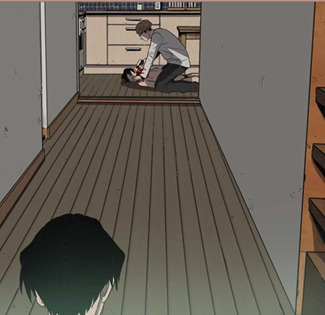
Since psychosis is a delusional disorder, it’s also known that those who suffer from it may believe that events or objects hold personal meaning or significance. Going back into Bum’s past again with his female friend, remember that he held personal meaning to objects that he otherwise should feel no connection to, objects that simply belonged to her. He’s stolen not only her bra, but her nail polish, and because he had such a connection with these items, used them to calm himself down when he would go into mood shifts.

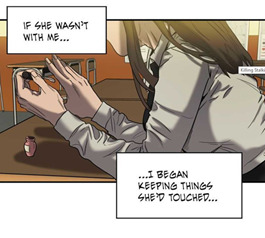
He’s mentally ill, and because of these disorders that alter his reality, he lives unaware of his problems. So, no, he isn’t stupid. To him, he’s doesn’t think his thought processes are out of place. In the first chapter, he claims that it’s complexly normal to stalk his crush and to want to know everything of his personal life. In regards to his obsessive behaviors and his kleptomaniac actions, he’s convinced it’s “because of love” over and over.
Though Borderline is the confirmed disorder at play here (and we can find many more examples to agree with it) it’s not a bad idea to toy around with some other possibilities. Other disorders are very likely in the cases of these characters and can help you reason with their actions. Take Stockholm syndrome for example. Stockholm syndrome is a condition that causes hostages to develop a psychological alliance with their captors as a survival strategy during captivity…Victims of the formal definition of Stockholm syndrome develop "positive feelings toward their captors and sympathy for their causes and goals, and negative feelings toward the police or authorities" (Wikipedia).

I’m sure you all remember this scene here, where the police officer tries to come to the rescue, yet Bum crawls away and keeps himself hidden. Or even the part where he chooses being back with Sangwoo over admitting to the police that he is need of some help. However in the case of Stockholm syndrome the positive feelings are rooted to the idea of survival, “captives often fear that their affection will be perceived as fake, they eventually begin to believe that their positive sentiments are genuine” (Wikipedia). Though I believe BPD is a bit more of Bum’s situation versus Stockholm syndrome, I think it’s worth a mention whilst defending Bum, anyways.
Though I haven’t really heard this one talked about prior to my mental disorder research for this analysis, I think Obsessive love disorder is worth a mention. Obsessive love disorder (OLD) is an extreme form of love that transcends into an obsession over time. It is characterized by an unhealthy attachment towards someone and can be triggered off by many factors such as anxiety, insecurity, and vulnerability (Buzzle.com). OLD is very similar to Borderline Personality Disorder, attachment disorders, and even erotomania, and so this could easily apply to many of my examples in the BPD paragraphs above. However, “depending on the intensity of their attraction, obsessive lovers may feel entirely unable to restrain themselves from extreme behaviors such as acts of violence toward themselves or others” (Wikipedia). Though we see that Bum has had self-harming instances in the past due to his living situation, we see the return of self-harm when Sangwoo was unpleased with these stories of his past. Bum spirals, feeling worried about the reaction and he quickly tries to make Sangwoo feel better, yelling at him to take it out on him physically. Sangwoo remains unresponsive, and Bum resorts to self-harm using a knife on the countertop, while shouting and sobbing that he knows he is disgusting.


Though my main focus here seems to be on Yoon Bum, it’s definitely no surprise that Sangwoo would fall into some mental disorders of his own. I’ve read fan discussions claiming that he too suffers from BPD, but I think too that he has psychosis, and sadistic personality disorder. Yes, that last one is a thing. “Sadistic personality disorder (SPD) can be defined as a type of personality disorder in which an affected individual inflicts sadistic, cruel, manipulative, aggressive and demeaning behavior on others. Violence and abusiveness are the hallmarks of the social relationships of a sadist. Such people lack empathy and concern for other individuals and derive pleasure by hurting or humiliating others” (hxbenefit.com). This shouldn’t need much textual evidence, as this is practically a description of the character as a whole. Backing up to psychosis, which remember is a delusional symptom, it wasn’t uncommon for Sangwoo to hallucinate or become delusional when panicked. For example, remember when he carried Bum’s fainted body to his bed to tuck him in?
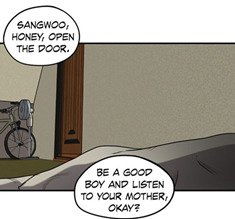

He becomes delusional, hallucinating that his mother is outside of the door, telling him to clean up his messes downstairs. His hallucination of his mother becomes angry and she rattles the door handle viciously, screaming at him. Then, he even hallucinates that Bum (who in reality is passed out beside him) raises his head to remind Sngwoo that he’s becoming his father.
So now to reiterate my point; these characters are not dumb. They are not “asking for it”. Bum is not a “creepy, gross attention whore”, but he has trouble regulating his emotions and has a hard time grasping a distinction on his reality. One of the largest reasons for hate in this fandom is ignorance to the reality and depth that this story possesses. Especially to younger fans, who simply were seeking some twisted BL, it is important to consider this story in terms of our mentally ill paired protagonists as honestly being mentally ill. Because this story is talked up as “horror yaoi”, many people aren’t aware or don’t consider the seriousness that this story aims to share. This is why there is a “you’re gross”, “go kill yourself” stigma on readers of Killing Stalking. Instead, us readers should be viewed as readers of a psychological thriller who analyze and respect the depth here for what its intended to be. The romanticizing and narrow-minded interpretation of this storyline is what causes so much hate and controversy. I’d love to see more serious consideration and in-depth analyzation going on in the fandom to remove the stigma that us fans are nasty, twisted, or gross.
I hope this was easy enough to follow and that you’ll give this story another read-through with these points in mind, and even change your outlook with the soon release of season 3. Let’s work to defend the author, these boys, the storyline and us fans with some knowledge! Also, again, disclaimer that I’m no professional nor am I “attacking” anyone with these disorders. Remember too though that psychosis is one of my most prominent beliefs here (so even if you suffer from BPD for example, without psychosis some of this may not sound accurate in terms of your own self).
695 notes
·
View notes
Text
Critical Jam #12: An Unflinching Look
Welcome to the final Critical Jam, J.A. Micheline’s monthly column on criticism.
This series began by positing itself as “an attempt to take an unflinching look at what we do,” so it is only fitting that it ends with an unflinching look at what I have done with it across the last year.
As an artist--and really, as a thinker--I have generally been interested in art as a method of self-discovery. My fictional work and my criticism, at their best, have both invariably revealed fears, joys, concerns, and beliefs that I was hiding from myself. Criticism is partially enthralling as it seeks to unearth truths and solve mysteries: What does this text mean? Why does it mean this? How did it mean this even if that wasn’t its intent? I use these questions to understand the world, myself, and texts in similar fashions. So it follows that occasionally it becomes necessary to turn my sights on my own criticism and learn.
Though I appear firm and certain on this particular angle in the column’s inception, “Quis custodiet ipsos custodes?”, the implication of criticism as its own artistic endeavor that runs through the text is not a belief I realized I had until the piece itself was written. This is perhaps most evident in the fact that I never actually say so. I get as far as the idea of criticism as existing its own end, but I don’t take this all the way to its obvious conclusion: that I view this work as art, with its own aesthetics and performances. It’s not a massive loss, but at the same time, the piece would have been stronger if I’d known exactly where I was arguing from. I wasn’t quite sharp enough to see what I was doing at that point. I couldn’t See that in myself, just yet.
The thread continues in the fourth installment, “On True Criticism,” in which I very uncharacteristically hedge about the notion of criticism as art--a tepid ‘could’ instead of strong ‘is’--but it wasn’t until two months ago, in the tenth piece “We Must Be Better,” that I was able to stand firm about this idea. Amazingly, it happens so quickly, in a piece that focuses more on the political responsibilities of criticism than the nature of criticism itself, that if you blink may miss it: “[...] as much as criticism is art,” I say, “–often some mystifying combination of eloquence, delicacy, and brutality–it is also, as you know, work.” It took nine months (and nine pieces!) for the strength of my rhetoric to evolve from subtextual premise to frank statement.
I’m particularly satisfied that this formal declaration snuck its way into “We Must Be Better,” as one of my main critiques of the column is the seemingly wide gulf between my discussions of the form as art versus as a political tool. If criticism is art and art is politics and criticism is politics, then my attempts at bringing these elements together as a critic of criticism especially could have been more rigorous. A third of the pieces address criticism as an interrogation of systemic injustice--but they seem more externally responsive than cohesive to the larger body of work. That is, it is evident to me that I have written them in response to particular emotions or events rather than, as I have done in the other set of pieces, simply exploring an idea that is interesting to me. There’s a sense of urgency or despair that is fitting to the material, but not quite fitting with the other eight texts.
It may be that this is just the reality of criticism involving systemic injustice. These are matters of life and death, so their writings will inevitably be fraught with emotion. But I remain generally dissatisfied by how lacklustre some of this work feels, rhetorically speaking. “All Rhetoric Matters,” does not feel particularly moving because it is basic. The first portion--All Lives Matter and Not All Men as a critical unit--is passingly interesting as I don’t think I have seen it elsewhere, but on the whole, the piece didn’t bring me anywhere new. Instead, it just saw me repeating the same things I’ve said on Twitter in a more cohesive fashion. It is nice that I have written this all together in one place, but it is more akin to an FAQ response than robust criticism that I feel truly proud of. This is in part because I am constantly having to repeat myself on this score and am therefore bored. This is also in part because the discourse surrounding marginalized issues is so low that it’s impossible to get into, say, the deeper possible emotional significance of a numerical value. But some of it must also be my own shortcomings.
Looking over many of these pieces, they feel necessary but neither inspiring nor critically fascinating. There’s no swagger. I didn’t stunt. I didn’t dance. I can push myself harder, even if what surrounds continues to try to drag me to their level. I could have done so. I should have.
There are angles available to me that I could have taken more time to parse, angles that touch upon art, injustice, and criticism all at once. For example, I mention “sovereignty” in what is likely the best of my pieces on injustice within this series, “It’s About Ethics in Marginalized Criticism.” Here, at least, I have done well to meticulously walk down several of the ethical quandaries of criticism involving a fellow marginalized person and, not unlike this piece, to criticize my own criticism. But sovereignty is an idea that crops up in the work somewhat unexpectedly. It’s an idea I remember floating at the time of writing, but never really digging into. A quick Command-F reveals that the notion of sovereignty within marginalized politics and issues appears five times within the essay. But at no point do I actually draw out the idea of sovereignty, what associations that word has, and how it has functioned politically. Instead of making the same old furious and basic motions, I could have completed a critical assessment of sovereignty and marginalized people/critics as nations living within nation-states. I have to demand more of myself. I read most of these overtly political selections and feel not just exhaustion but also regret about my performance as an artist. I can barely look at “A Right to be Hostile in 2016.” Despite their being the most important pieces, they also feel the weakest. It’s disappointing that, with the stakes as high as they are, I did not also have it in me to make something beautiful. It’s disappointing--but I suppose it also does make sense.
By now it is quite evident that I spend a lot of time asking for higher performance from myself--so the discovery of calm and optimism as a theme in this column has been pleasant. Much of the work comes from a place of warmth, an attempt to tell my peers that they’re working very hard, that they’re doing just fine where they are. Of course, I can See now that I was only telling myself. I view myself as a pessimist/realist, but this column seems to land me firmly on the optimist/idealist spectrum, which is very peculiar. After defining criticism as art, I go on to defend 10/10 reviews, welcome anyone and everyone into the critical field, celebrate critical positivity in the face of pressures to be negative, and present conflicts of interest as a weak challenge to our prowess. It’s a very unexpectedly “believe in me who believes in you” line of criticism and not too different, actually, from a line of criticism that treats the work as sacred, and therefore critics (artists!) as such.
My favorite piece, both in this vein and overall, must be “Psalm for the Newly Anointed.” In truth, it feels like the natural conclusion for the column. My writing on scanlations, which follows it, was interesting and asked a great many questions--but I did not feel that it truly belonged with the rest of the work, much in the same way that the more political pieces felt discordant. Perhaps because there were too many questions and not enough confidence. Or maybe simply because the subject was manga, rather than Western comics. As a whole, this column seems to suffer on the fronts of tone and pacing. But the psalm!
I cannot deny feeling that the psalm is almost perfect. I regret, perhaps, linking to some old writing about postmodernism that I now think could have stood to be more rigorous and precise, but otherwise the piece seems quite strong. What I like most is that it pulls on themes of previous pieces as well as itself--criticism as a grassroots endeavor, Seeing, the creation of a critical canon by citation of a peer. But it takes all of that and shapes them into a narrative that first, is consideration of capitalist and postmodernist hierarchies, and then evolves into one of the spirit, commenting even on the function of the spirit itself. The language is good, the frameworks are good, but what is really good is that this, more than anything, is representative of how I think and feel about criticism. There’s an element of spirit and holiness that comes into the work--evidenced by the evocation of religious language in the piece, certainly, but also scattered in the language I have chosen to use here.
The connection between the coldness of the work and the warmth of its love, even in anguish, is the key to everything that I do. I show affection to myself and to others by criticizing. I see better for myself, better for us all. I expect more. I insist, truly, on being my own god.
A year on, I can largely look on these works without despair. This may change in two years or three, but for now, the work still feels good. I’d hoped, I think, to spark conversation among my peers and was only successful once or twice--but still, what little I’ve done here has been an interesting experiment and largely worth it, if only for creating one piece that I love deeply. Critical Jam ends here, but the need for self-improvement and self-examination from myself and my peers and my field does not.
Thanks for coming.
I appreciated all of you and all of this.
I’m sure I’ll see you again very soon.
Previous: What We Talk About When We Talk About Scanlations
Thanks for reading. If you enjoyed this piece, feel free to click here and buy me a coffee or follow me on Twitter at @elevenafter.
11 notes
·
View notes
Text
Yesterday, Hero Club converged on Vanderbilt Hall in Grand Central Station for Tamashii Nations 10th Anniversary World Tour: New York City! For those who may be unaware of the event, it is a two-day event showcasing upcoming products from Bandai’s sub-division Tamashii Nations. Tamashii Nations is known for its work with anime/manga and tokusatsu properties to create high-end collectible figurines, and accessories. In addition, Tamashii Nations has expanded its lines to include living individuals such as Michael Jackson, Bruce Lee, and WWE Superstars as well as characters from DC, Marvel, and Star Wars.
The event is elaborately set-up to be like Japan’s own Tamashii Features events, or its Akiba Showroom. Dragon Ball is the focus point of the exhibit, as a balloon display for Shenron and the Dragon Balls hang over head. Furthermore, there is a large statue of S.H.Figuarts Super Saiyan Goku Awakening Edition on display, and an area for attendees to get pictures taken of them riding the Nimbus Cloud. There are at least eight to ten displays for Dragon Ball, consisting of S.H.Figuarts, S.H.Figuarts ZERO, Tamashii Buddies, and Absolute Chogokin figures. For the regular S.H.Figuarts a majority of them are separated into their individual series, and arcs. The new reveals are S.H.Figuarts for Kid Goku, Korin, Gotenks, Majin Vegeta, and Super Saiyan God Goku. Furthermore, almost every existing figure is on display with exclusion of Broly, and previously teased Champa and Vados. One of the best displays for the Dragon Ball S.H.Figuarts is the circular which attempts to show the evolution of the series as a whole.
#gallery-0-17 { margin: auto; } #gallery-0-17 .gallery-item { float: left; margin-top: 10px; text-align: center; width: 16%; } #gallery-0-17 img { border: 2px solid #cfcfcf; } #gallery-0-17 .gallery-caption { margin-left: 0; } /* see gallery_shortcode() in wp-includes/media.php */
Yet, among the area set-up for Dragon Ball there are a few displays set-up to feature the event exclusive items one can purchase. Now, these items are limited to two per customer and have a limit on how much can be sold per day. The stock is incredible low too, so items tend to sell out within less than the first 90-minutes. The Saint Seiya Myth Appendix Gold Cloth set is out favorite display piece due to the fact it is paired with the Saint Myth Cloth Goddess Athena – Original Color Edition. Whereas, the other exclusives including S.H.Figuarts Kaio-Ken Goku are just shoved into one display case. The only things any of our staff managed to obtain was the limited-edition World Tour Tamashii Stages, and single Saint Myth Cloth Aries Cloth. Luckily, Bluefin Tamashii has a booth set-up with current items, as well as pre-sale items to buy such as Soul of Chogokin Daizyujin as its Power Rangers’ release, as well as the S.H.Figuarts for Street Fighter and Dragon Ball Xenoverse 2. Near the sale booths is a display promoting Premium Bandai’s launch for its North American website, showcasing items like S.H.MonsterArts Mothra Special Color Edition, S.H.Figuarts x Ultra-Act Ultraman Limiter Release Ver., and various Robot Damashii Gundam figures.
#gallery-0-18 { margin: auto; } #gallery-0-18 .gallery-item { float: left; margin-top: 10px; text-align: center; width: 20%; } #gallery-0-18 img { border: 2px solid #cfcfcf; } #gallery-0-18 .gallery-caption { margin-left: 0; } /* see gallery_shortcode() in wp-includes/media.php */
Now, on one side of the hall is the anime and video game related section, and on the other is mostly live-action properties. However, somehow the S.H.MonsterArts Godzilla display managed to end up with anime stuff. In that section, there are two displays for the various Sailor Moon items, two displays for Naruto, and a Megaman display which is shared with Neon Genesis Evangelion. There is even displays for Kinnikuman and Street Fighter, but we unfortunately could not get close enough to snag photos of those displays at the time. In that section, the biggest standout was the preview for the Digivolving Spirits 01: WarGreymon; possibly a new line of Digivolution figures for Digimon. Furthermore, Tamashii Nations has a page on its website with a countdown clock that is winding down to the series’/ figure’ reveal in 26 days! We now, eagerly wait for further information on this item…
#gallery-0-19 { margin: auto; } #gallery-0-19 .gallery-item { float: left; margin-top: 10px; text-align: center; width: 16%; } #gallery-0-19 img { border: 2px solid #cfcfcf; } #gallery-0-19 .gallery-caption { margin-left: 0; } /* see gallery_shortcode() in wp-includes/media.php */
Then as for the opposite side of the hall, it features the live-action properties as mentioned it earlier. There one can find a Power Rangers display for the Tamashii Buddies and Soul of Chogokin Megazord. Two other cases then feature the S.H.Figuarts WWE series, Marvel Cinematic Universe series, and various DC films (somehow we lost the pictures for the WWE & DC displays). The Meisho Movie/ Manga Realization series receives a lot of love at the event, as it seems to take up a solid third of this section. While we were examining the figures, we were often crowded by others just curious at this overly unique line of figures. Also on display is the upcoming releases for Chogokin R2-D2 and C-3P0. Among this area is another teaser/ prototype for Soul of Chogokin Gipsy Danger, along with promotional artwork for Pacific Rim: Uprising’s Gipsy Avenger.
#gallery-0-20 { margin: auto; } #gallery-0-20 .gallery-item { float: left; margin-top: 10px; text-align: center; width: 25%; } #gallery-0-20 img { border: 2px solid #cfcfcf; } #gallery-0-20 .gallery-caption { margin-left: 0; } /* see gallery_shortcode() in wp-includes/media.php */
Now, after purchasing one’s items, and checking everything we really insist one should check out the “Try Me” booth. There anyone can get a feel for some S.H.Figuarts, and get to test out the Soul of Chogokin Megazord. Our staff really feel in love with that product, as it is a wonderful representation of the mecha. The last day for the World Tour is today, and we hope that those interesting in attending the event can get a chance to stop by. We also hope that this is not the last time New York is graced with an event like this from Tamashii Nations!
Tamashii Nations 10th Anniversary World Tour NYC
Yesterday, Hero Club converged on Vanderbilt Hall in Grand Central Station for Tamashii Nations 10th Anniversary World Tour: New York City…
Tamashii Nations 10th Anniversary World Tour NYC Yesterday, Hero Club converged on Vanderbilt Hall in Grand Central Station for Tamashii Nations 10th Anniversary World Tour: New York City…
#Anime#Bandai#Bluefin Tamashii#Darkon633#DBZ#Dragon Ball#Dragon Ball Super#Dragon Ball Z#Featured#GundamLegacyExtreme#Hero Club#Marvel#Marvel Comics#MCU#Mighty Morphin Power Rangers#Naruto#New York#Premium Bandai#S.H. Figuarts#S.H. MonsterArts#Spider-Man#Star Wars#Super Sentai#Tamashii Nations#Tamashii Nations World Tour#Tokusatsu#Ultraman#Wheelchair21
2 notes
·
View notes
Text
SUPERVERSIVE: “Magi” is an awesome show and that you don’t know that is sad
I’ve realized that unless I think the battle scenes and characters are really, REALLY awesome I actually prefer watching people deal with politics and economics. This is the exact reason “Log Horizon” is such a great show, and one of the things that makes “Fullmetal Alchemist: Brotherhood” so great are the vast background machinations going on between various semi-independent groups that may or may not be at odds with one another.
“My Hero Academia” is that rare show that has action scenes that are so awesome and characters so memorable that I’m happy with them being the focus of the show, and ditto with “Yu Yu Hakusho”. My second favorite shonen (to MHA), however, is not particularly notable for its action scenes (which are at a perfectly passable level) or its characters (which are never offensively terrible but are hit and miss in terms of memorability and creativity). What it is absolutely great at is dealing with the political machinations of its world and in making its characters act realistically within it.
This show is “Magi: The Labyrinth of Magic” and its sequel season “Magi: The Kingdom of Magic”, and it is a damn shame that they have fallen so far under the radar in recent years.One can be forgiven for thinking it’s a typical shonen action show if one only watched the first arc, or even the first two arcs (at least the second, by far the show’s weakest, is very short). It’s a fairly straightforward adventure story about quirky characters who meet up in an Arabian-inspired fantasy world and decide to run off with each other and go treasure hunting. Even so, as far as those stories go the characters are entertaining, particularly Ali Baba, who soon becomes the most interesting and complex character in the entire show, and one of my all-time favorite anime characters. The action is fun.
And there are points of interest even here. “Magi” does an admirable job of not whitewashing the horrors of the Arab world while at the same time making its appeal clear. The world is beautiful, atmospheric, and has an air of adventure, but the social systems are cruel and suffering is commonplace. Ali Baba himself fluctuates wildly between bravery and cowardice in a way not really common among protagonists in shonen shows, and the hints at his mysterious backstory are well-placed.
The second arc unfortunately moves away from Ali Baba and focuses on Aladdin, a cheerful 12 year old and the titular magi, which at this point as far as we know means he has especially strong magic powers and is friends with a genie. This arc is easily the worst of the show, focusing on Aladdin’s relationship with a small tribe of desert people who find themselves suddenly at odds with the massive Koh Empire, a growing world power with the goal of eventually getting, through force or otherwise, the entire known world under their thumb. The main thing to take out of this arc is the introduction of the Koh Empire, an explanation of the show’s magic system, and the show’s running theme of the perils of globalism that make the show especially timely. Outside of that, the best I can say about this arc is that it’s mercifully brief.
In between this is an arc following the character of Morgiana. I’ll get to this later.
Luckily, it is after this that the show REALLY hits its stride. What follows is the Fog Troupe arc, and I think I can honestly say that it’s one of my favorite arcs in any anime ever. Aladdin returns to the kingdom of Balbadd to meet up with Ali Baba and passes through the kingdom of Sindria, lead by Sinbad. Yes, this is THE Sinbad the Sailor. Magi makes the interesting decision to have our characters find Sinbad when he is already a powerful and well-established king (there would eventually be a prequel series about the rise of Sinbad that was entertaining enough). Aladdin decides to travel with Sinbad, who is on his way to Balbadd himself to deal with a mysterious group known as the Fog Troupe that have been robbing his merchants.
And it is there that Aladdin and Sinbad discover the shocking truth behind the Fog Troupe’s shadowy leader, a discovery that leads to a chain of events that rapidly spiral out of control.
Right. In terms of summary I’m going to stop here. It is from this point on that the show moves from “Good” to “Great”. The Fog Troupe arc delves deep into the difficult political situation in Balbadd, the difficulties inherent in finding ways to deal with it, the decisions made by other nations when they notice the quickly unraveling stability of the nation, and the backstory of Ali Baba and how that affects his actions. Interspersed in this are some truly stellar battle scenes. Ali Baba comes into his own as an outstanding character, one of the only ones I’ve ever seen who is capable of carrying both entirely comedic and entirely dramatic roles in the narrative equally well. In fact, the only other character I can think of with that ability is Vash the Stampede. Now that’s good company!
The very best thing I can say about the Fog Troupe arc is that the show manages to maintain this level of quality, or close to it, for the entire rest of its run! Season 2 actually leaves Ali Baba behind for the majority of it but the complex social structures it explores along with the behind scenes machinations of the various competing nations makes it damn near just as compelling as the best parts of season 1, and sometimes even more so.
I mentioned above that I would get to Morgiana, and I will. Morgiana is a somewhat unusual character in that she doesn’t actually HAVE to be involved in anything going on but continually makes the decision to join our other protagonists of her own accord. Freed from slavery by Ali Baba despite the fact that she also tried to kill him under the orders of her master in the show’s first arc, Morgiana’s original goal is to return to her people’s homeland but she eventually comes to the conclusion that she owes too much to Ali Baba to leave him behind in the middle of such a huge crisis.
I could summarize a lot of the show without mentioning her but I decided to bring her up here because I would be doing her a disservice if she was never mentioned. Morgiana is a great character. Her personality is actually interesting! She plays a distinctly feminine role in the narrative as support for the male leads, and acts incredibly grateful to them because of her kindness. She is essentially superpowered due to her race, which is what makes her so valuable as a slave, but she uses that power always in service to others. Her character arc partially plays out in a separate arc but it is very well-handled. Her scenes also tend to be very fun – because of her powers the animation tends to be very on point when she gets the spotlight (take a particular look at her animation in the first OP, because wow).
She also has one of the most interesting character designs I’ve seen yet for an anime heroine. She is supposed to be a foreigner and she actually looks like a foreigner. She’s pretty, but there is something slightly unconventional about her appearance that really makes her stand out amongst the rest of the cast in the best possible way. The actress also manages to somehow make her actually sound like a former slave – there is a sort of quietness to her voice that gives the impression she is unused to voicing her own opinions or expressing strong emotions. This is a credit to the English voice actress, who does an excellent job imbuing the character with a unique personality.
I really wish I could talk more about the specifics of what makes the show great, but for once I don’t want to spoil things. When it explores the complex social and class-based differences that lead to the chaotic and dangerously tyrannical structures of the various governments it does so without forgetting that there are multiple parties involved, that even the underclass aren’t necessarily blameless when it comes to their circumstances, and that the line between oppressor and oppressed is far less black and white than it originally appears. And yet it does all of this without ever compromising on the idea that good and evil exist and it is our duty to do good. That a shonen action show manages to explore ideas in such depth while still managing to feel like a shonen action show is incredibly impressive.
There isn’t much else to say about the show except, I suppose, that it’s very pleasant. The show benefits greatly from scenes where the characters just hang out with each other. It makes their relationships feel realistic, and their comradery feel earned. This helps a lot when the main cast gets separated for any length of time. They can meet up and hit it off immediately without anyone feeling like they missed anything.
If I had one comparison to make of the show, I would call it a somewhat inferior version of “Fullmetal Alchemist: Brotherhood”, and since I consider “Brotherhood” one of the greatest shows of all time this is still a very high compliment. It breaks a lot of interesting ground for a shonen in the complexity of its international and social politics.
Unfortunately I think its first two arcs got it to slip under the radar a bit, and that’s really a shame. After I finished season 2 (and the fun if rather slight prequel “The Adventures of Sinbad the Sailor”) I actually went and found the manga because I was so excited to continue the story, and so far I definitely haven’t been disappointed.
This is a true hidden gem and one of my favorite anime ever, and I highly recommend it…if only to drum up enough interest for a season 3!
Two final notes, ones I make often:
The dub is really excellent, especially the voices of Ali Baba and Morgiana, who manage to cover an impressive amount of range. If you look for that sort of thing this one is definitely worth it.
Every OP and even ED is killer in this show, though my personal favorites are the first ones of each.
Really fun!
SUPERVERSIVE: “Magi” is an awesome show and that you don’t know that is sad published first on https://medium.com/@ReloadedPCGames
0 notes
Text
Off the Shelf: Still kicking
MICHELLE: Melinda, after we finish this one we will have done as many columns in 2019 as we did for the entirety of 2015-2018! Go us!
MELINDA: *laughs weakly* Yes… “go us.” Um. Wow. When you put it that way, we sound terribly unimpressive.
MICHELLE: Well, the alternative would’ve been to let it disappear, so I think we deserve a bit of credit for resuscitating it! Anyhow, I expect that you’ve been reading some manga!
MELINDA: I suppose you’re right! WE ARE BASICALLY GODS.
…
Okay, maybe not. But yes, I have indeed been reading some manga, or at least rereading, which is to say that I took some time this week to look at the new omnibus edition of CLAMP’s four-volume manga, Wish, originally published in Kadokawa Shoten’s Mystery DX, adapted into English in the early 2000s by TOKYOPOP, and resurrected just a few weeks ago by Dark Horse Comics, with their usual omnibus treatment—larger trim size, very nice-looking print, and a somewhat refreshed translation.
For those who missed Wish the first time around, it’s the story of an angel, Kohaku, who has been sent to Earth to find Hisui, one of the four “Master Angels” (why they don’t just say “Archangel” is a mystery to me, but maybe there’s something I don’t get), who disappeared from Heaven after a visit to the bridge between Heaven and Hell. During their mission, Kohaku—who appears human-sized during the day but reverts to tiny cherub form at night—is rescued from an attacking crow by Shuichiro, a local human doctor. Complications ensue when it turns out that Hisui actually defected to Earth in order to be with Kokuyo, the actual son of Satan, with whom they have fallen in love. Meanwhile, Kohaku becomes confused by their own growing feelings for Shuichiro.
There’s a whole lot packed into this short series, including more angels and demons, time travel, reincarnation, messenger rabbits, cats (some of whom are actually demons), and a tree fairy, but generally speaking it’s all just incredibly CLAMP from start to finish, and if you’re into that, you know what I mean. Someone even sacrifices an eye. This thing honestly couldn’t get any CLAMPier. It’s not my favorite of their series—I could live very happily never reading another manga about angels for the rest of my life—but as most CLAMP fans will know, the big deal about this edition is the translation, which is certainly what caught my attention.
In CLAMP’s original vision, there is no gender in Heaven or Hell, but in early 2000s publishing, it was unthinkable to convey that in English, especially when it came to the angels, who, in Japanese, referred to themselves with genderless pronouns. This led to a decision to choose genders for each of the angels, based on heteronormative standards regarding appearance and romantic entanglement, outraging some fans but satisfying style guides. Fast forward to 2019, when publishing has finally recalled that singular “they” is a thing, and our angels are genderless at last.
I’ve already mentioned that Wish is far from my favorite of CLAMP’s work, so I wasn’t especially eager to reread it, but I was surprised to note just how much more enjoyment I got out of it this time around. As someone who identifies as nonbinary, I realize this may be of greater importance to me than most, but whatever CLAMP’s intention really was when they filled their comic with genderless angels, it feels like representation, and for something originally published in the 1990s, that is kind of a big deal. Freeing the angels from gender expectations breathed new life into them for me, made the story richer, and opened up its universe to the notion that love and attraction might be based on something other than a person’s gender expression or whatever reproductive organs they happen to possess. These are not novel ideas for many of us, but with all the hand-wringing over this series back in 2002, it feels revolutionary. Mostly, though, what I’m struck with as I read this edition, is how easy it would have been to publish it exactly as it is now, then. The sentences are not awkward. There is nothing that feels labored or unnatural in this translation. How has it actually taken publishing this long to figure that out?
MICHELLE: It’s been a long time since I read Wish, and it was also not my favorite, but I definitely feel a greater spark of interest when I imagine a translation that represents the angels as genderless! It makes me want to shake TOKYOPOP and demand, “Would that have been so hard?!?!” (They had other similar issues back in the day, too, and not just with genderless protagonists. I distinctly remember a character in GetBackers being assigned feminine pronouns when, in fact, he is very much a dude and if anyone had actually bothered to learn anything about the series they were translating, they would’ve known that. SIGH.) I can totally see how it would make the whole story richer as a result.
MELINDA: Yeah, nobody could be more surprised than I am to be describing Wish as “rich” in anything other than CLAMP’s beautiful, swirly artwork, but I genuinely enjoyed rereading it, and I’d even recommend it, at least to fans of shoujo manga, and particularly to other enbies. It’s an unusual treasure of representation for the time period. And messenger bunnies! Who doesn’t love messenger bunnies?
There is one jarring panel in the first volume, where one of the demons seems to misgender Kohaku as “she,” but I don’t know if that was an editorial oversight (that’s how it’s translated in TOKYOPOP’s version, too) or if it was actually written that way in Japanese. But in over 800 pages, that one panel wasn’t significant enough to mar my enjoyment overall.
So what did you read this week, Michelle?
MICHELLE: Maybe that demon was intentionally being a jerk.
I checked out the first volume of Hitorijime My Hero by Memeco Arii, one of the first boys’ love manga published in print by Kodansha Comics. (They did release a handful of others digitally in 2018.)
As a kid, Masahiro Setagawa hated tokusatsu shows because he knew that, no matter how miserable his life was, no hero would come to save him. But when he fell in with a group of delinquents in middle school and became their gofer, a hero did come in the form of Kousuke Ohshiba, the so-called “bear killer,” who defeated the thugs and ended up with Setagawa as his new underling. Setagawa befriended Ohshiba’s younger brother, Kensuke, and as the manga begins, some time has passed. He’s dealing with the fact that Kensuke is now in a relationship with another boy named Asaya Hasekura and that Kousuke is a teacher at their high school.
Almost immediately, Kousuke is confronting Setagawa about the feelings he believes Setagawa has for him, saying, “Even if you feel that way I won’t be able to return those feelings.” Setagawa is too dumbstruck to deny it, and then Kousuke (an adult) keeps sending him (a teenager) mixed signals, like suddenly smooching him or calling him “the guy I like.” It turns out that Kousuke is basically trying to make Setagawa realize he is gay. This eventually works. And then they do it. Eyeroll.
Because this series is a spinoff from an earlier series, we’re just kind of thrown into a confusing timeline and a mix of characters without a lot of context. I’ve seen the first couple of episodes of the anime, and they handle all of this material far more clearly. The manga does a little to show why Setagawa likes Kousuke—he’s strong, smart, and capable—but none at all to show why Kousuke likes Setagawa, aside from one page where he talks about how his devotion helped him retain his humanity or something. Really, it’s all pretty disappointing so far. I know it’s a popular series, so I’m hoping it gets better.
MELINDA: I can’t help but roll my eyes along with you. This basically sounds like a collection of my least favorite BL tropes, though maybe (hopefully??) at least without the younger, smaller guy wincing in pain and horror every time they have sex? Please tell me it at least doesn’t have that. Though maybe it doesn’t matter. I know the student/teacher thing is a common trope too, but I really hate it, especially when it’s the main romantic plot line. I know it’s a popular series, but I honestly can’t imagine reading it by choice.
MICHELLE: To its credit, it absolutely does not have that. It’s fully a fade-to-black scenario with some evidence afterwards that Setagawa enjoyed himself tremendously. As for the student-teacher thing, this is a slightly different variation in which the two people concerned knew each other for years before Setagawa came to the school where Kousuke teaches, so the power imbalance between them is not so much that Kousuke is in an official position of authority but that Setagawa has kind of idolized him.
MELINDA: Either way, I’m guessing it’s not for me. I’ll wait to hear what you think of future volumes before taking the risk.
MICHELLE: Okay. I can handle at least one more. Speaking of Kodansha’s advances into the realm of print BL, would you care to do the summary honors for our mutual read this time?
MELINDA: Sure!
This week, we both read the first volume of the much-anticipated series 10 Dance, by Inouesatoh, also from Kodansha Comics, as Michelle mentioned above.
The story involves two ballroom dancers with similar names—Shinya Sugiki, who is an international champion in Standard Ballroom, and Shinya Suzuki, who is the Japanese national champion in Latin Dance. Their relationship with each other is both admiring and rivalrous, and when Sugiki asks Suzuki and his partner to train with with him (and his partner) for the 10-Dance Competition (combining the 5 Standard and 5 Latin dances), Suzuki finds it impossible to refuse.
Over the course of the first volume, the four dancers train together—the men in particular working to be able to lead in each other’s specialty—and that’s literally all that happens in the story, but as we watch the two of them butt heads (and other things) throughout the training, it’s honestly just riveting. This story is all about personality and relationships, and certainly we’re expecting some steamy romance between the two male leads down the line, but even in this preliminary volume, where nothing overtly romantic happens, there’s so much interpersonal entanglement to enjoy.
The two men couldn’t be more different. Suzuki, who grew up in Cuba, has been dancing with his partner since childhood, while Sugiki changes partners constantly, never quite settling in with anyone. Suzuki’s strength is showing passion on the floor, while Sugiki’s is the elegance of his form. And though things are slowly heating up a bit, I honestly believe I would be happy just watching them dance together as I learn new details about Standard and Latin ballroom rules, pretty much forever. It’s that entertaining.
MICHELLE: I enjoyed it tremendously! From the start, the cover art reminded me of est em, and the content within does, too. With est em, I was always struck by the way her characters would talk while engaged in intimate acts, and although Sugiki and Suzuki aren’t having sex, they’re still engaged in physical activity—indeed, they’ve been dancing until dawn together for months—that puts them in close proximity, gettin’ sweaty, maintaining eye contact, et cetera. And they’re talking throughout, gradually becoming closer and revealing details about their personal lives in the process. I love the slow development of their relationship and how this, in turn, makes small moments so pivotal. The one that stands out is when Sugiki has gone to London to defend a championship title. When he succeeds, it’s Suzuki that he calls, and when this reserved man actually smiles when being told “Hurry up and come home,” it has such impact! Of course, they go right back to butting heads after that.
MELINDA: I agree on est em, though I’d go even further and say it feels like an est em/Fumi Yoshinaga hybrid, with the additional warmth of their observations about each other’s habits and idiosyncrasies and the scene where they dance together at a restaurant, because trying to make points about dance while sitting at the table just isn’t working. It’s got all of est em’s sexiness and suave, along with Yoshinaga’s warm goofiness, and the underlying elegance of both.
MICHELLE: “Warm goofiness” is a great way to describe the scene where Sugiki, frustrated by Suzuki’s attempts to lead the waltz, gets Suzuki to adopt the woman’s role and proceeds to very thoroughly make him feel like a princess. “I feel like I could pop out a dozen babies for you right now!” And you’re absolutely right about elegance, too; these dance scenes are drawn so beautifully.
If you’ll forgive somewhat of a non-sequitur, although I don’t know the kanji used for Sugiki and Suzuki’s given names (and, indeed, it might not even be the same), one definition for “shinya” has a meaning that’s very applicable to the story. Check it out.
MELINDA: I believe I read somewhere that the kanji for each of their names is slightly different from the other, but I’m tickled by that meaning all the same. It certainly is appropriate!
Bottom line, I can’t wait to read more of this series, and I’m thrilled that Kodansha brought it over for us!
MICHELLE: I enthusiastically concur!
Thanks for joining us for another installment of Off the Shelf! The winner of last column’s giveaway is Joseph Miller! Joseph, send over an email or drop a message to Melinda on Twitter to collect!
By: Melinda Beasi
0 notes
Text
30 days of suikoden challenge , day 4 ——
favorite star of destiny from suikoden iii
when i was eight ( or maybe ten, idr anymore ) years old, my sister and i played suikoden 3 all the way through once or twice together, voicing the cast together, and from that tender and impressionable age, i fell in love with one character in the game who became my absolute favorite and my very first fictional character crush ( probably ). in high school, my only ever nanowrimo story centered around exploring this character and developing his story because he was given nowhere near the attention in the game that he deserved. to this day, he remains my favorite overall suikoden character and even my dad knows who he is. this character is none other than sasarai.
it’s weird to think now that i didn’t really know anything about sasarai ( and luc’s ) appearances in suikoden 1 and 2 prior to last year — i pretty much only knew about their roles in s3, and to be fair i got really invested in just that. my sister always preferred luc as a character, but sasarai’s always been my main. looking back on it, there are a number of shallow, aesthetic reasons for this, none of which are a surprise to anyone who knows my “type” of fictional character.
1. he’s androgynous. my weakness for pretty, androgynous men is crippling, honestly.
2. he’s a bishop and socio-politically high-ranking, both of which are also types i tend to find really interesting. especially in a place like harmonia, which is like the seat of corruption in the suikoden world, it’s so fascinating to think about how one navigates all those politics from such a high position. it’s made pretty clear that while he is one of the most revered figures in harmonia ( being not only a bishop, but also a true rune bearer ), this in no way makes him invincible. the structure of harmonia is such that anyone is vulnerable, and no one has unlimited power. sasarai knows how much he can do, how far his influence can extend, and when his hands are tied. arguably, being in such a high position only makes him even more vulnerable. i love thinking about people in these kinds of positions; every move he makes is carefully calculated in order to navigate the web of harmonian politics, and he does it expertly.
3. his outfit in suikoden 3 is really pretty?? i’ve always loved harmonian colors / clothing / architecture / design, and it’s a vast improvement from his mushroom hat thing in s1 and 2. cosplay goals.
ironically, though he’s a great unit in-game ( one of the best support mages you can have, though he joins really late and doesn’t even get his true earth rune until the final fucking battle ), his type of unit isn’t actually what i go for at all. i tend to prefer making every single one of my units into a one-man army, and sasarai’s support role doesn’t generally fit my play style. that being said, i use him every fucking time anyway because i love him so much. his combat role also says a lot about him as a character, too, and fits him — he’s a back-row mage, intended to remain distant from combat, casting support spells for his allies and occasionally doing some damage when the going gets tough ( i always give him a pale gate rune for this purpose ). in s3′s dynamic battle system where units actually move around the field, his tendency to remain separate from the fray becomes even more noticeable.
and i mean, that’s totally sasarai. he’s a very competent mage, but he’s a bishop and a high-ranking politician first and foremost. he doesn’t get his hands dirty; he’s got spies and soldiers to do that for him. he’s there for morale and for leadership. i love it when that comes across in combat role too.
of course, the meat of the reason why i love him comes from his unspoken narrative. ( which never got expanded on because they decided to cut sasarai’s story and i will never not be crying about all the things i could have known! now you’re just somebody that i used to know...... ) the manga adaptation goes a lot more into his side of things, thank god, and from there we get a much better idea of his character. he’s absolutely 100% a pampered dandy — luc is totally right when he says that sasarai is harmonia’s little sheltered puppet. he doesn’t go against what harmonia tells him to do, doesn’t question things much. however luc is also being a little bit unfair because sasarai isn’t blind or stupid. he’s very smart and cunning — you don’t survive long in his position otherwise — and very savvy at his role. however, it’s true he doesn’t think outside of it much.
though he’s been raised in such a corrupt society, however, he’s neither hoity-toity nor cruel, and on a personal level isn’t actually morally corrupt.in fact, he’s surprisingly kind, and despite being a skilled general, dislikes violence. i like to believe that, had he the ability, he would have wanted to make life easier for the le buque citizens. but the truth is that though he would have had compassion for them, he never saw their situation in le buque firsthand, and i doubt he would have been permitted to see how poorly they were treated by harmonia overall. he also probably would have had a case of ‘not in my backyard’: the situation is regrettable, but there does have to be some kind of order maintained in the world, etc. he is loyal to the harmonian agenda, after all. ( and it’s this dichotomy between his national loyalty and his personal sense of compassion that’s so interesting to navigate. )
i also enjoy the fact that even though he is also proper and formal when he needs to be, at base he’s surprisingly nonchalant. i don’t totally remember the scene from the manga, but he laughs during a moment when someone addresses him in a way that would otherwise be considered very disrespectful to someone of his rank. it’s a genuine laugh, and not at all condescending. in fact, for him, to some extent it must be nice to be spoken to genuinely. in the manga, he truly wants to help luc towards the end, and tries to make up for abandoning him before ( “you’re my brother! let me help you!” ) even though the abandonment wasn’t his fault. granted, the moment is rather naive of him, but the intent and the gesture are in earnest; by this point, he’s begun to realize the truth, and wants to redeem luc.
the fact that he learns that he can’t is what brings about his post-game character development that i like to think about so much. though the game never depicts it, it’s clear he’s probably left in some kind of existential angst afterwards. after all, luc pretty much shattered his sheltered view of harmonia — the revelation of what he and sasarai are literally sends sasarai into shock enough for luc to steal his true earth rune — and then sasarai is greeted with the reality that he is not only unable to save his brother, but that luc hates him and what he stands for. that the institution and country he has served faithfully all his life led to someone being so hurt and twisted that they ended up where luc did. ( and y’know there’s also the realization that he’s not only a hypothetical puppet for harmonia, but very much a literal one. he’s not even his own person, really; he’s a clone. so how much of him is him and how much is manufactured? that’s enough to turn anyone’s world upside down. )
what sasarai ends up doing post-game, then, is anyone’s guess. suikoden 3 tells us he’s plagued by existential crisis as he returns to his post as bishop. does he do anything about it? does he end up trying to reform or change anything ( and can he? ) that’s up for people to imagine. but it’s this sheer wealth of potential as a character that makes me love him. there’s so much in store for his tale and he comes very far as a character over the course of only one game, from a well-meaning but complacent bishop to a man who’s had the reality of the world shoved on him and then is left to do some soul-searching.
honorable mentions: franz ( true runner up ), chris lightfellow, percival fraulein, nash, futch, sharon, dupa
0 notes